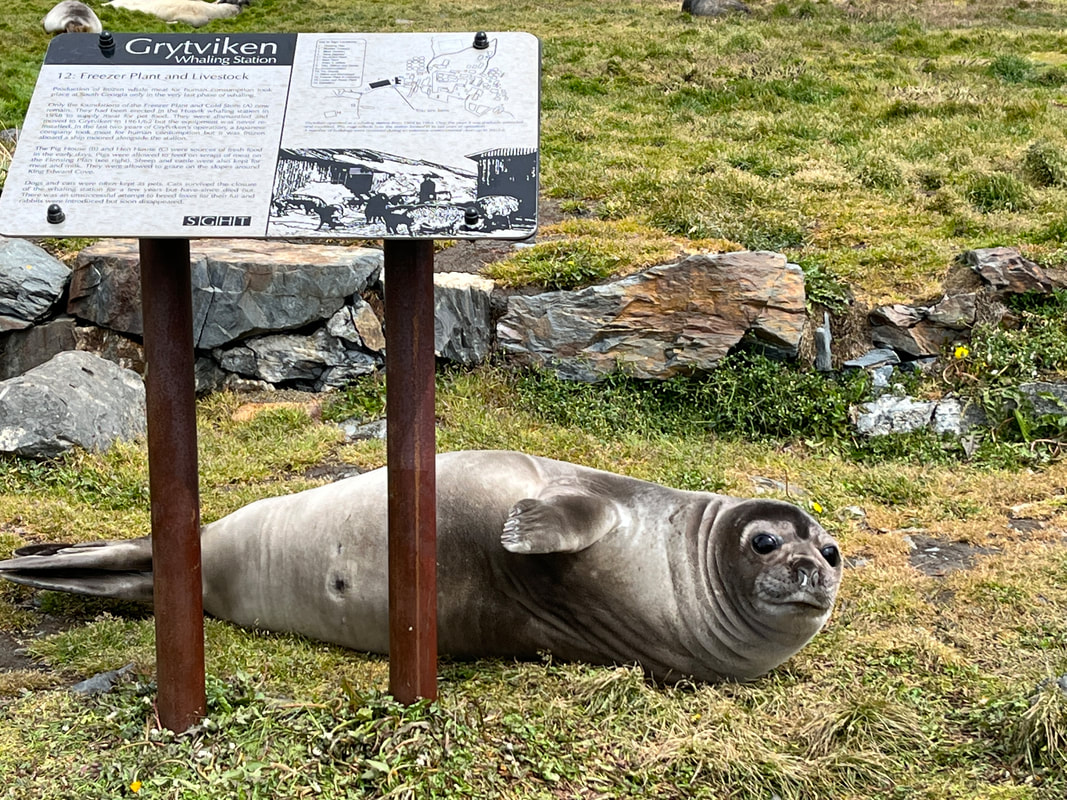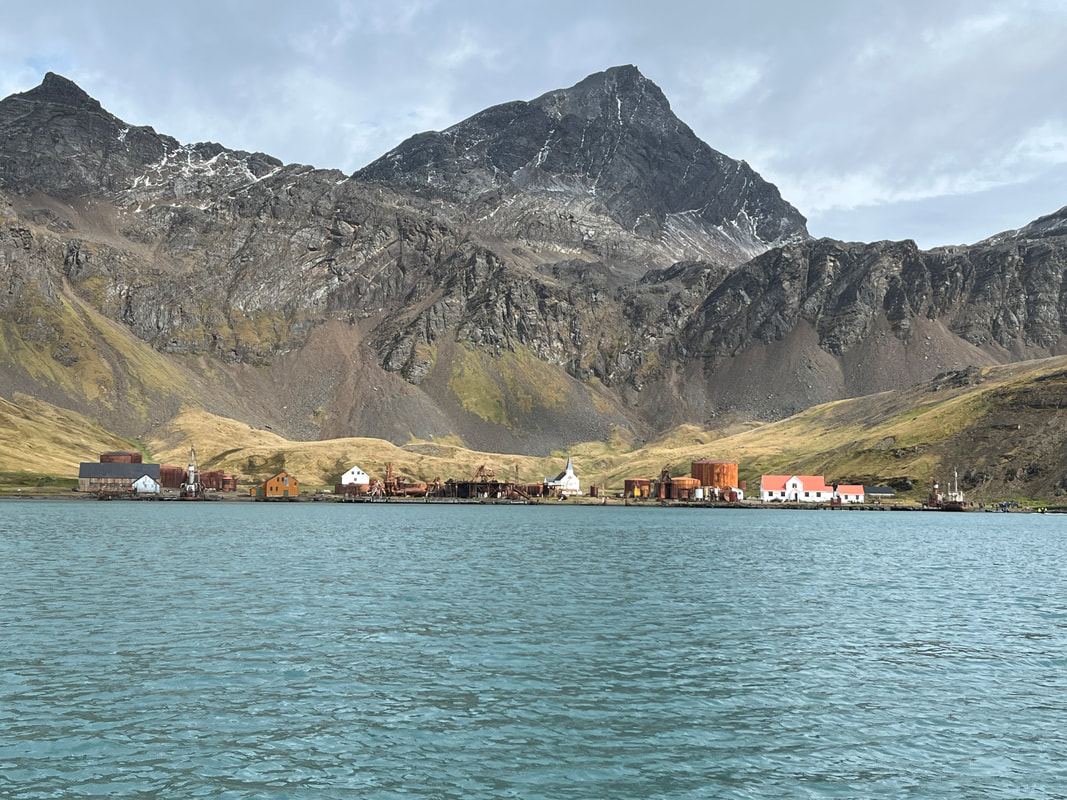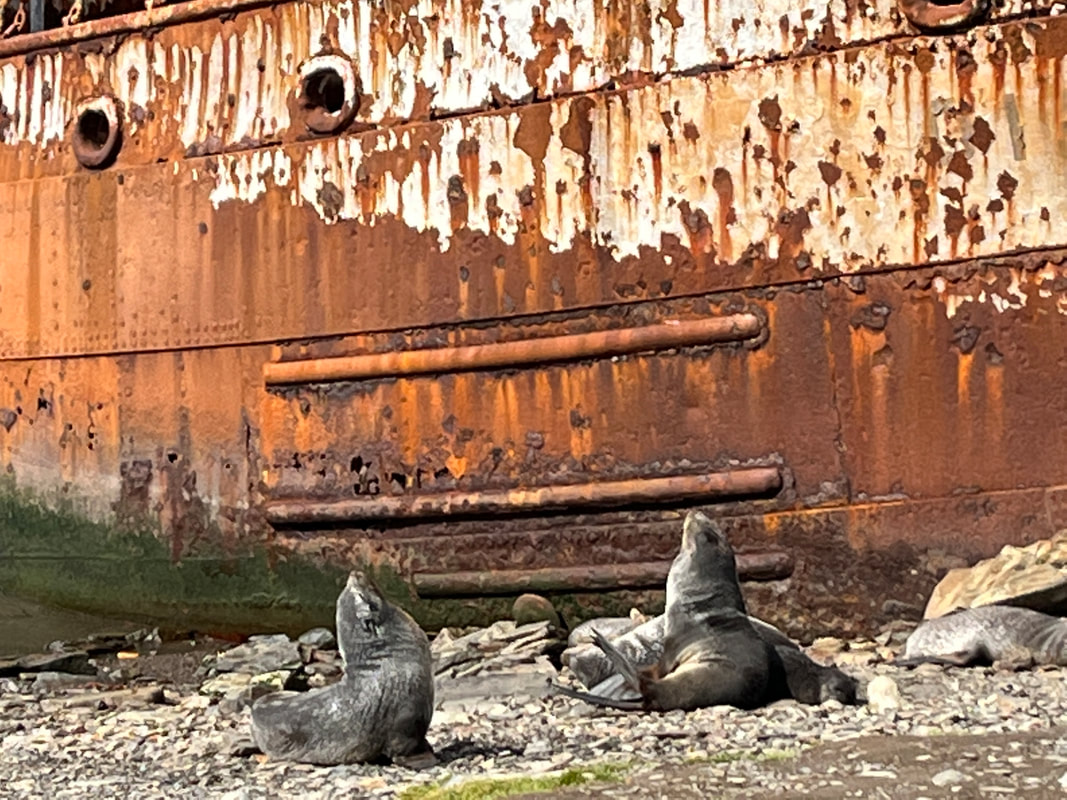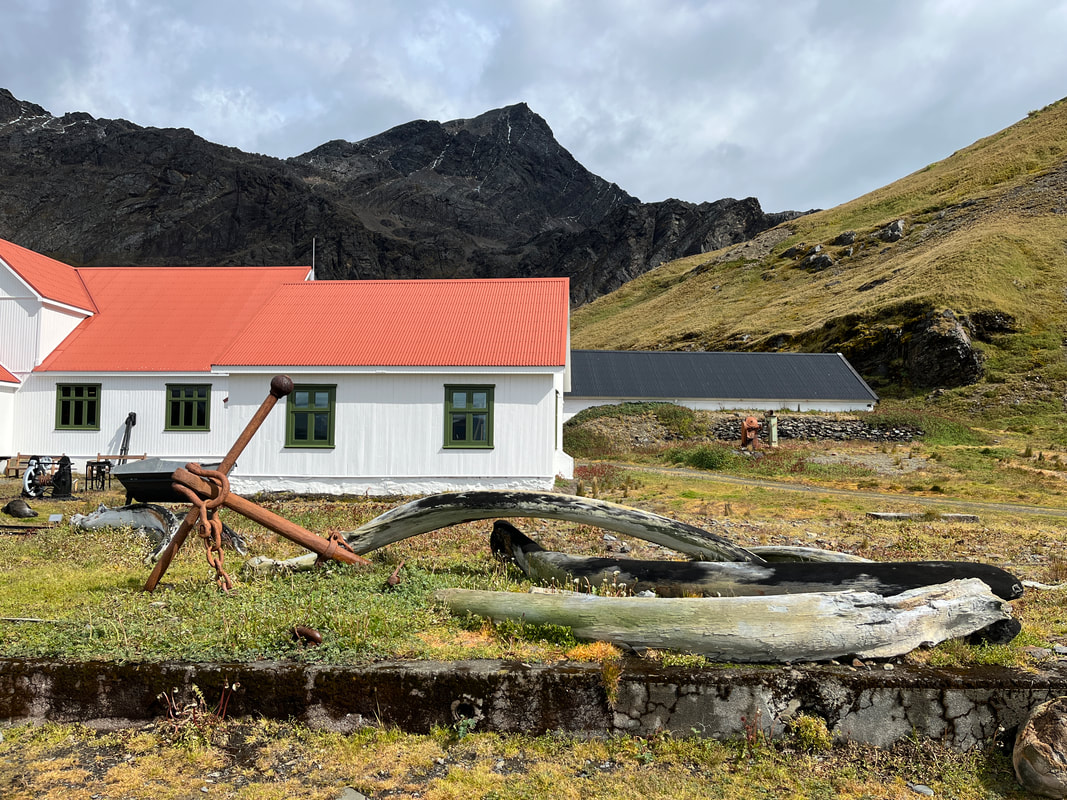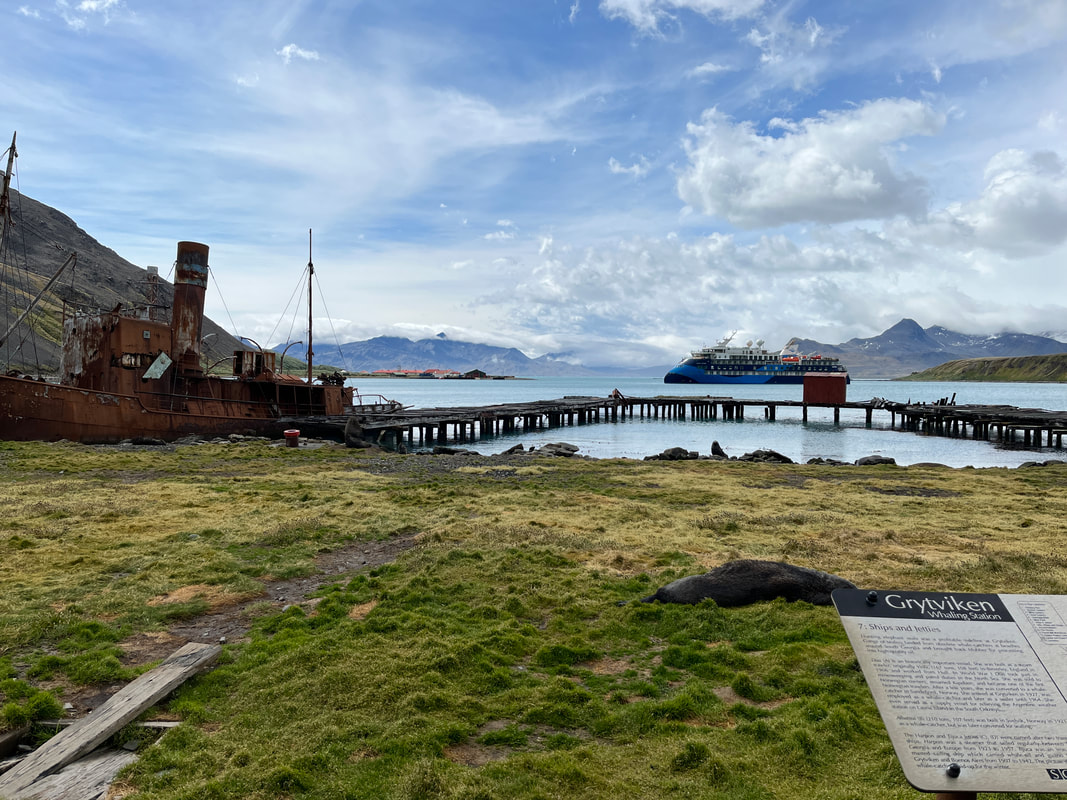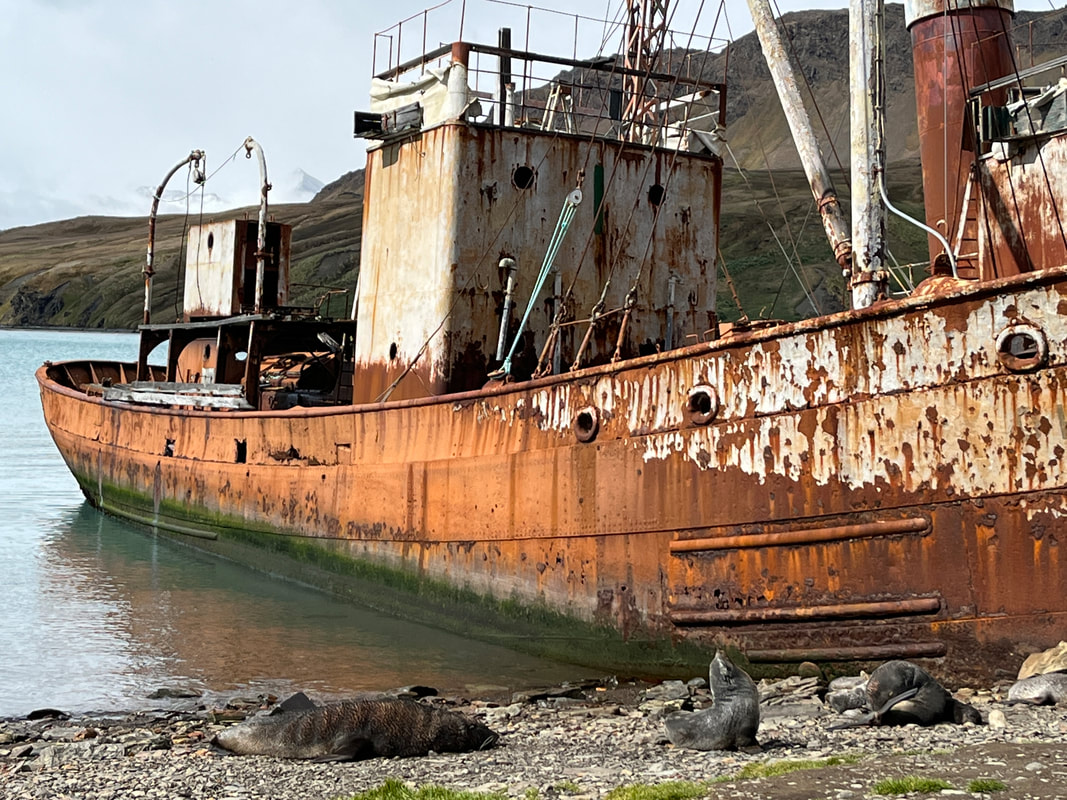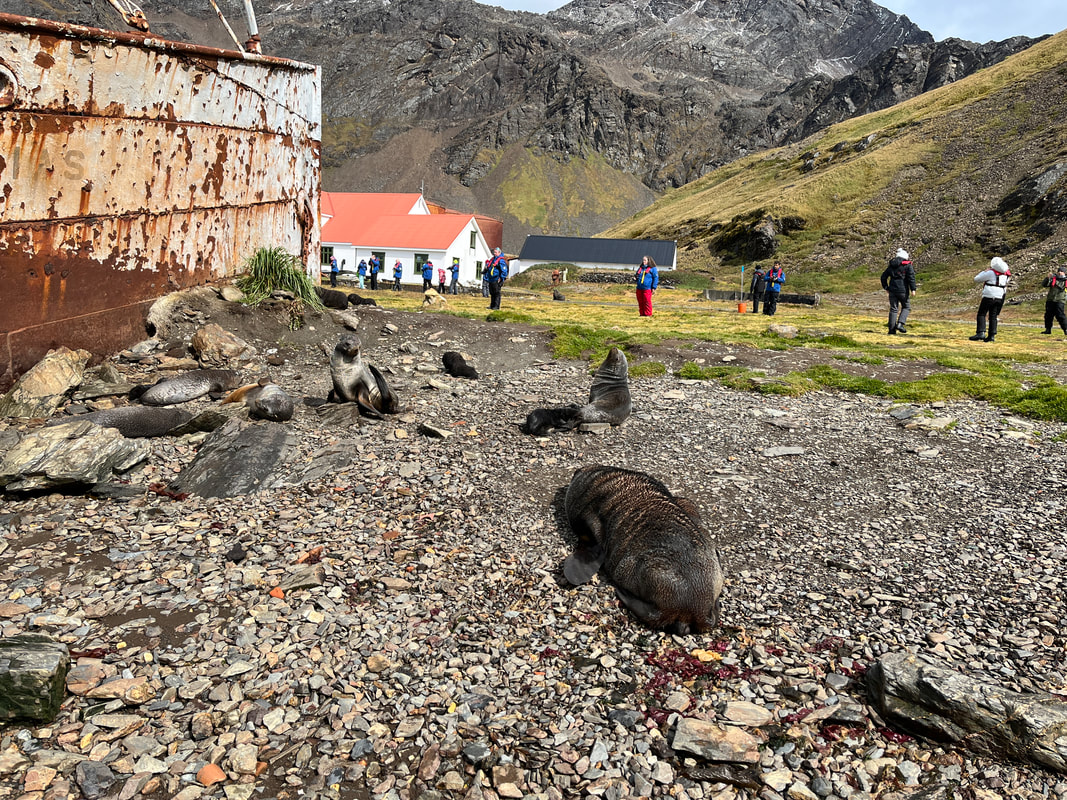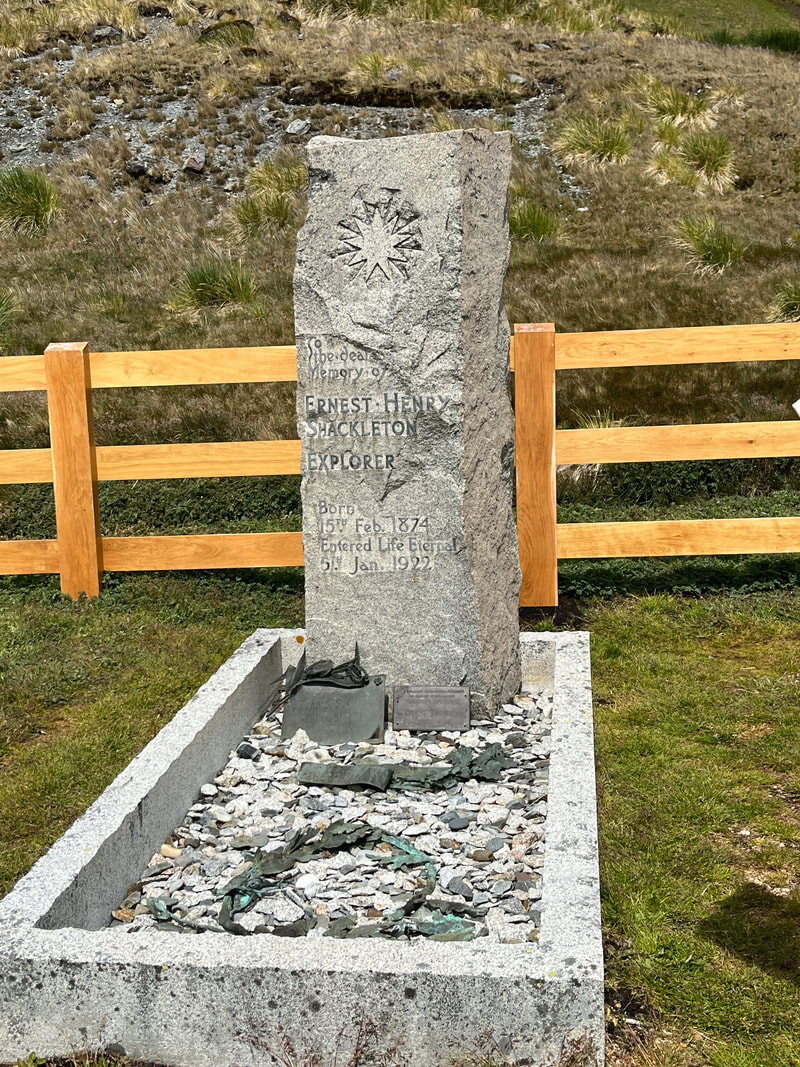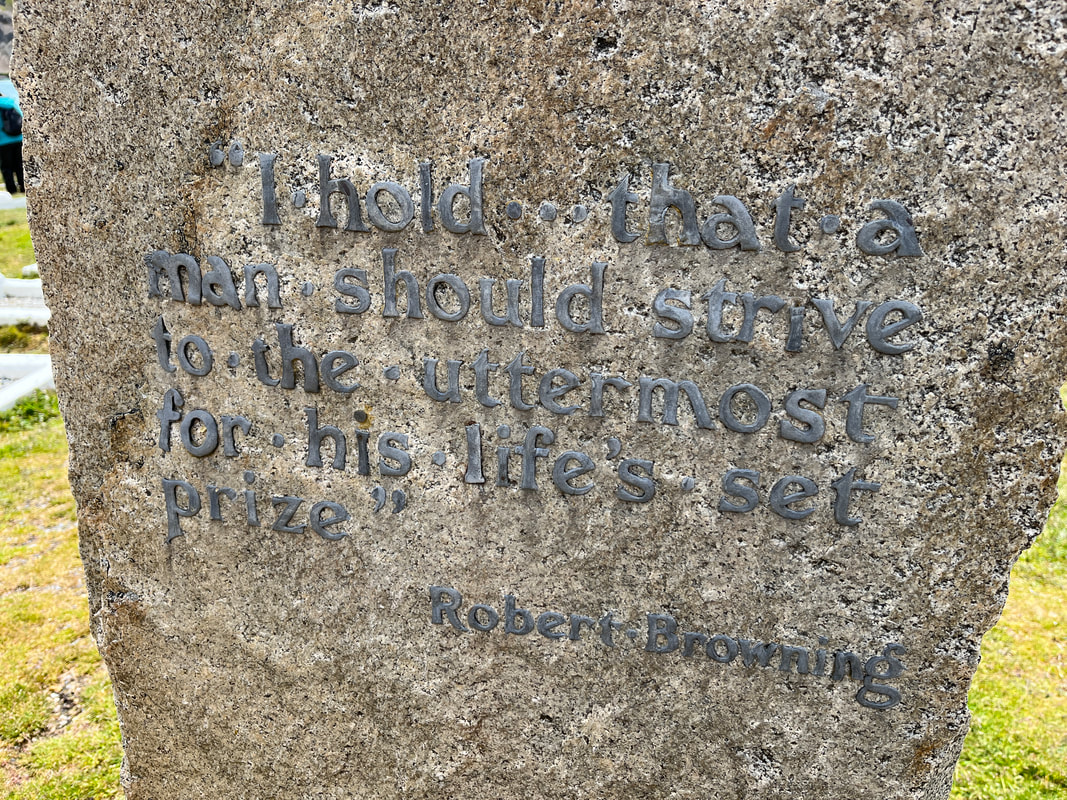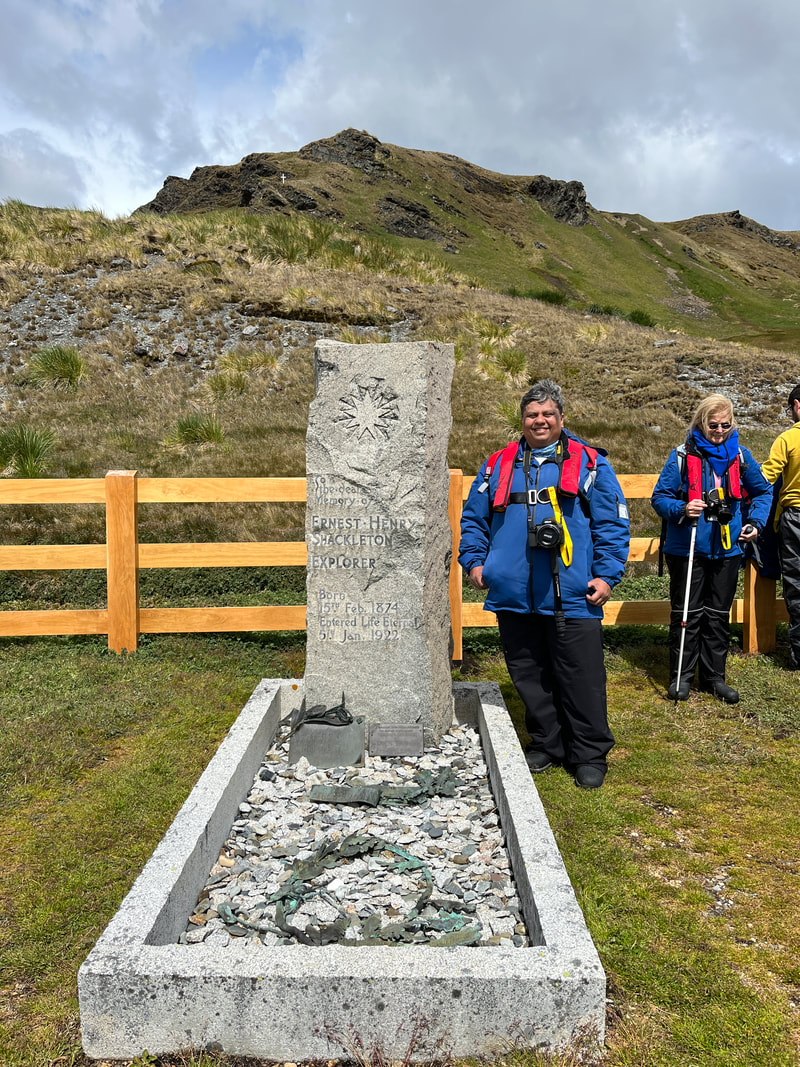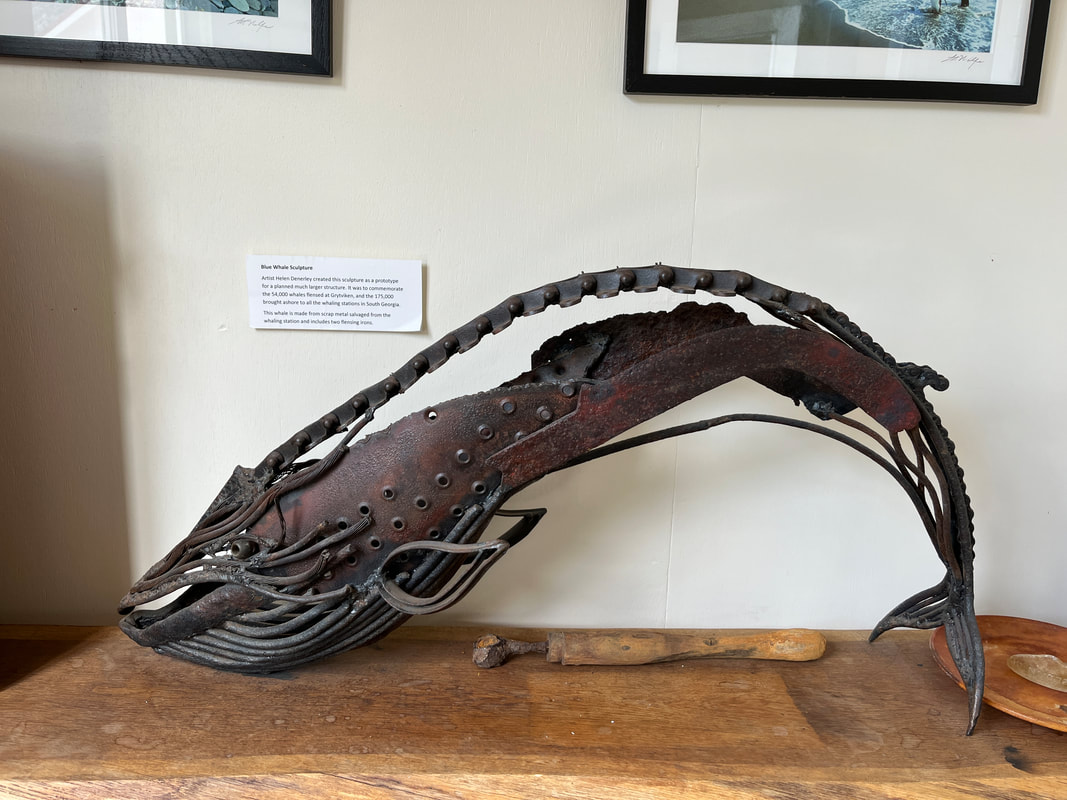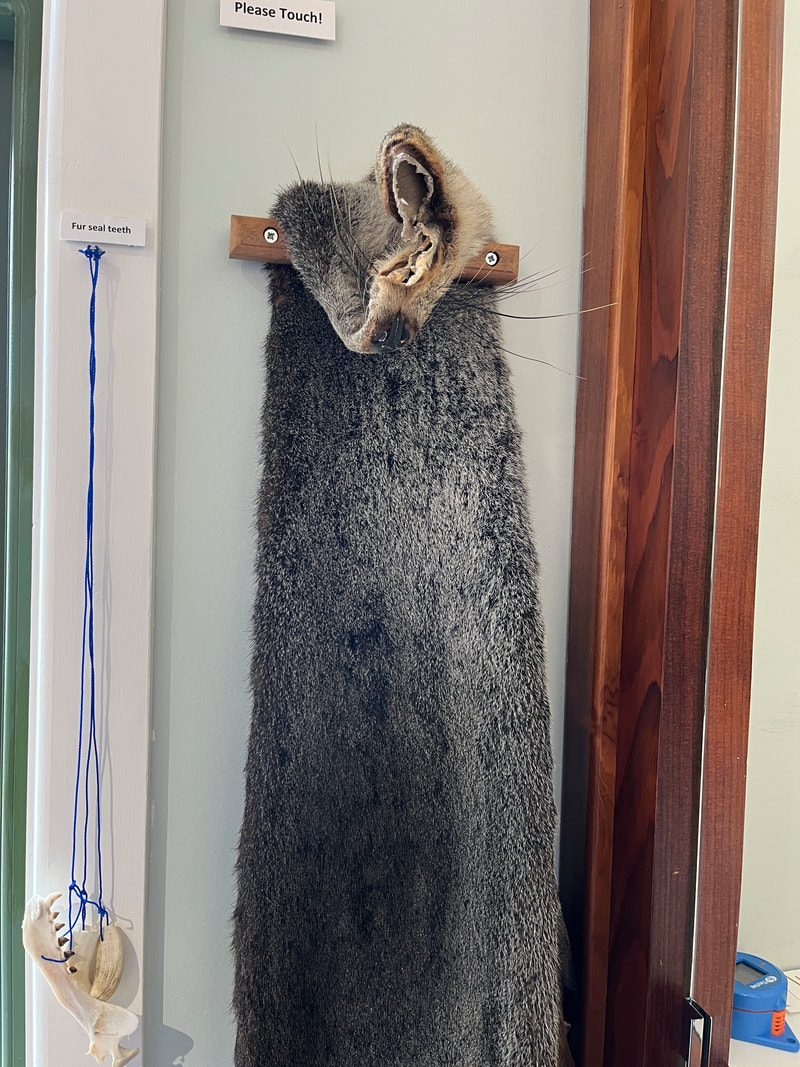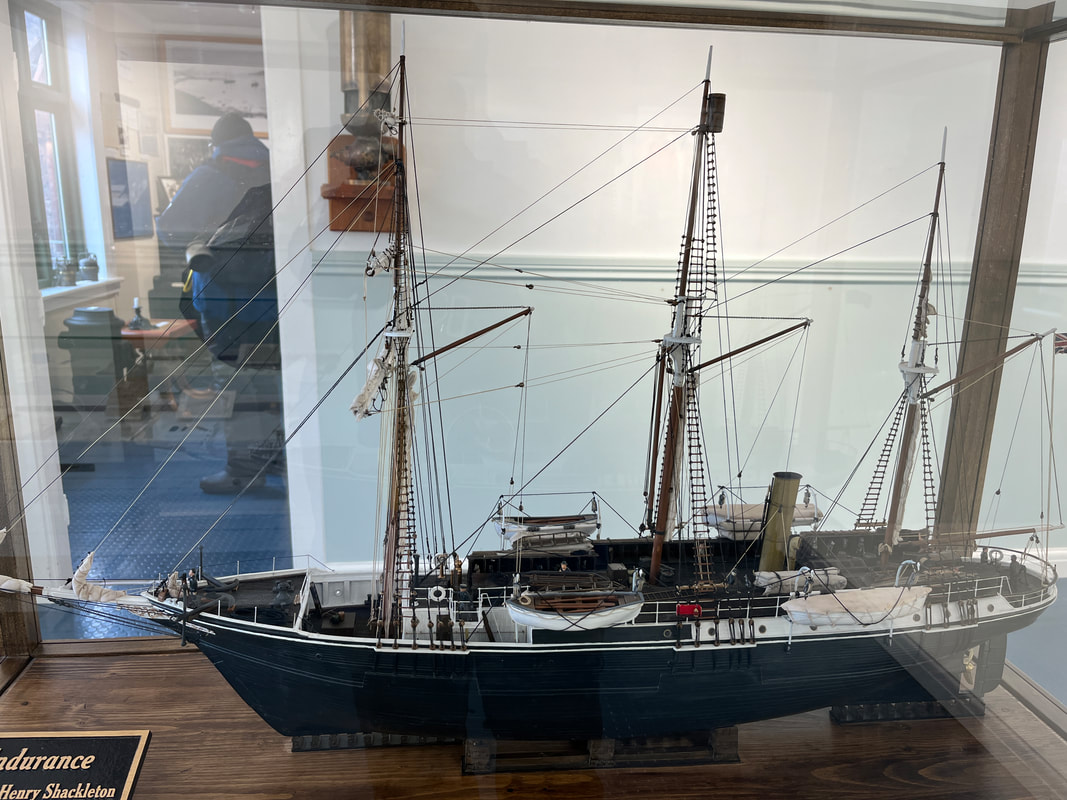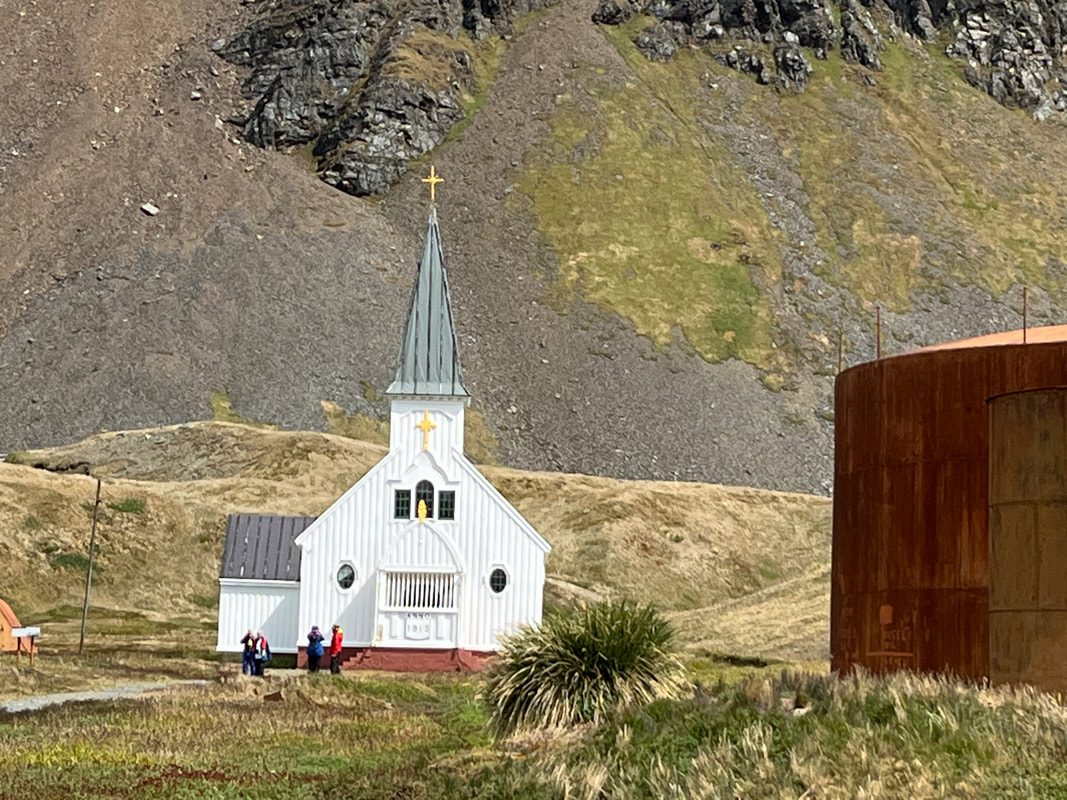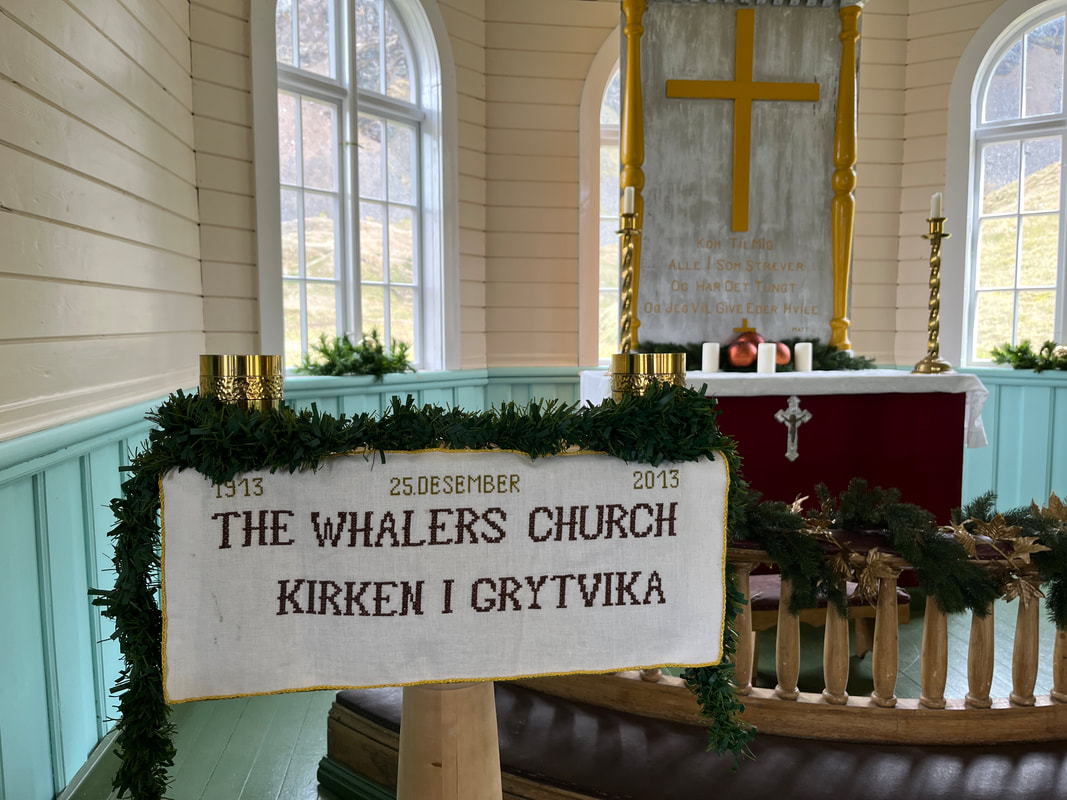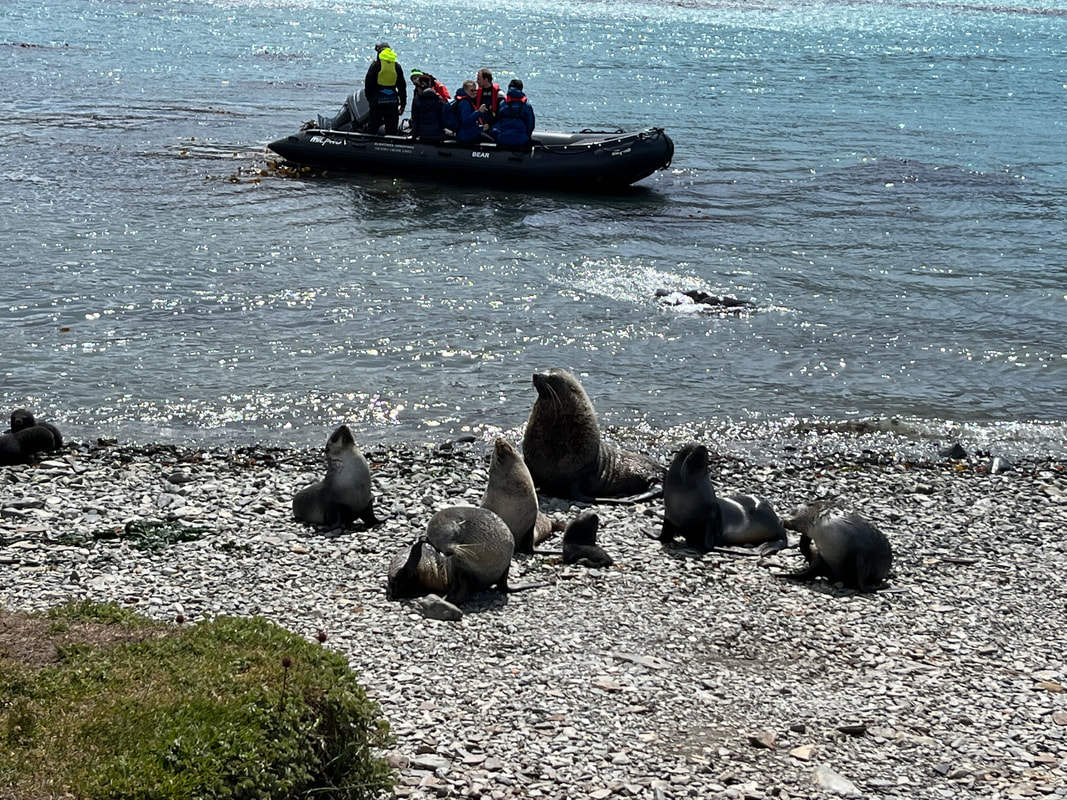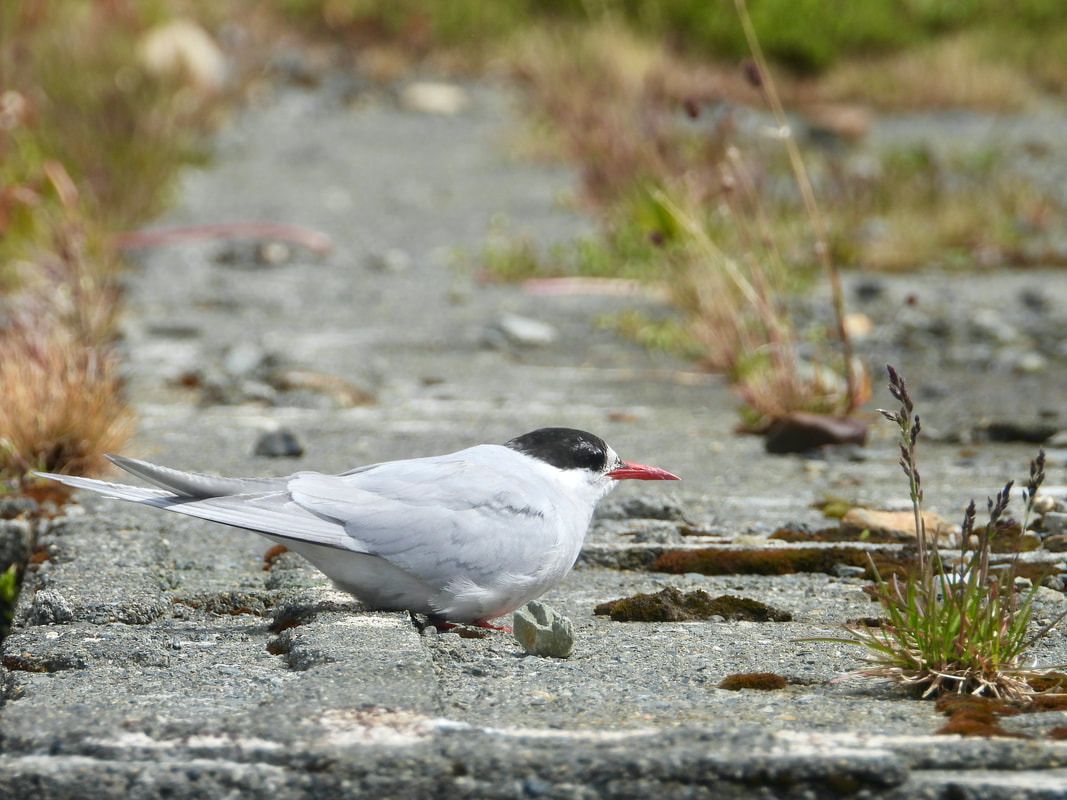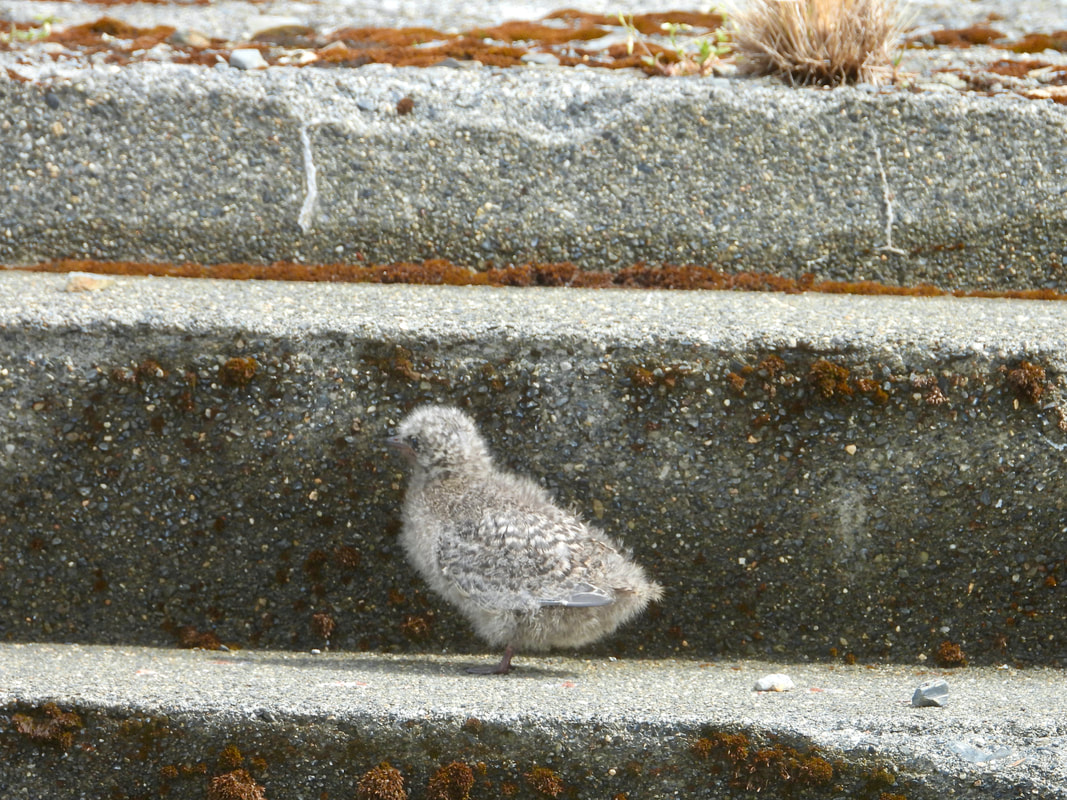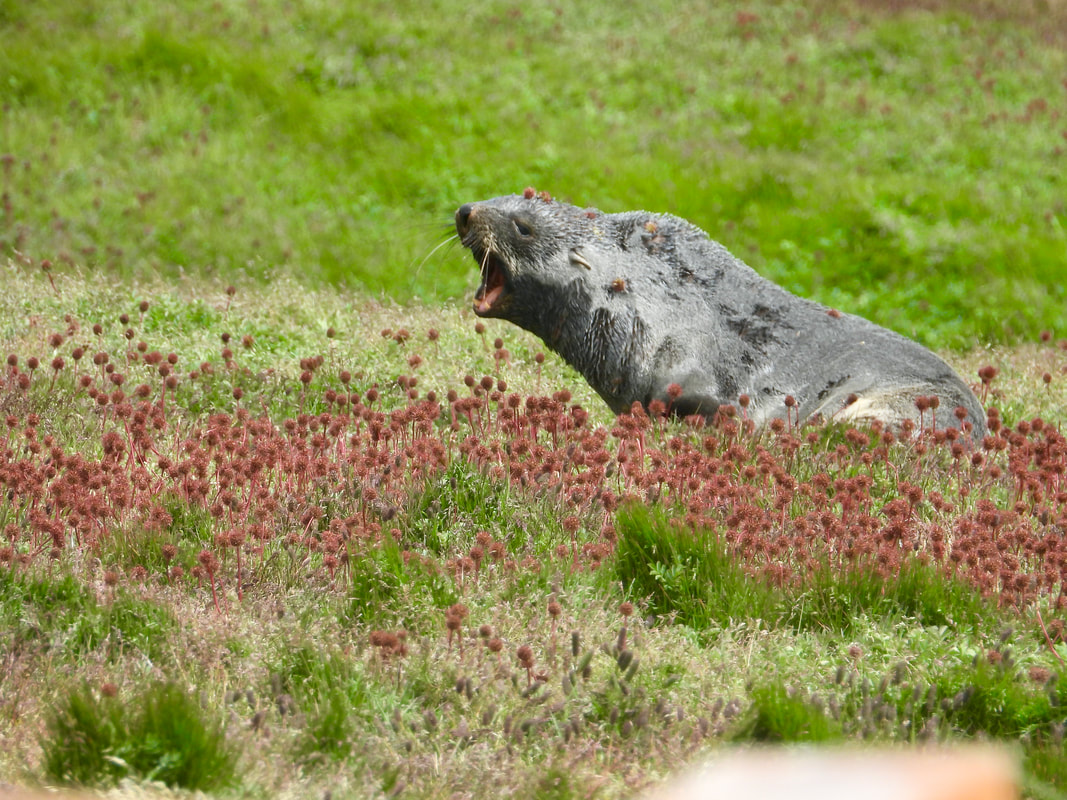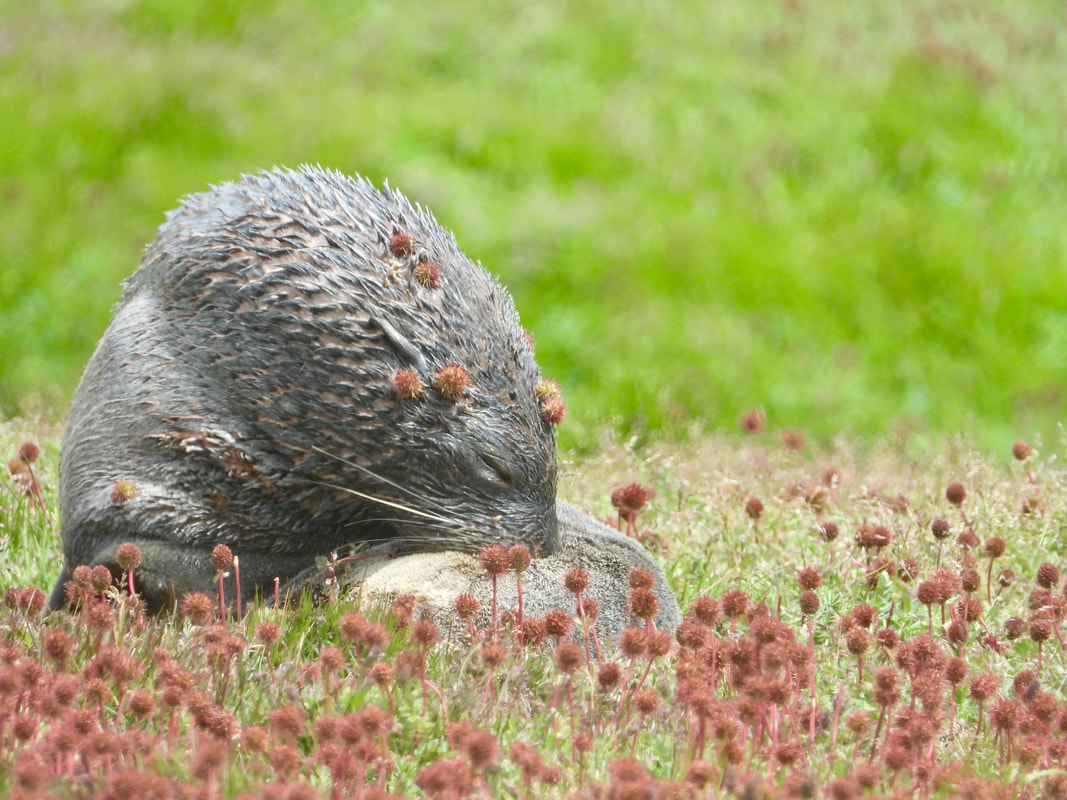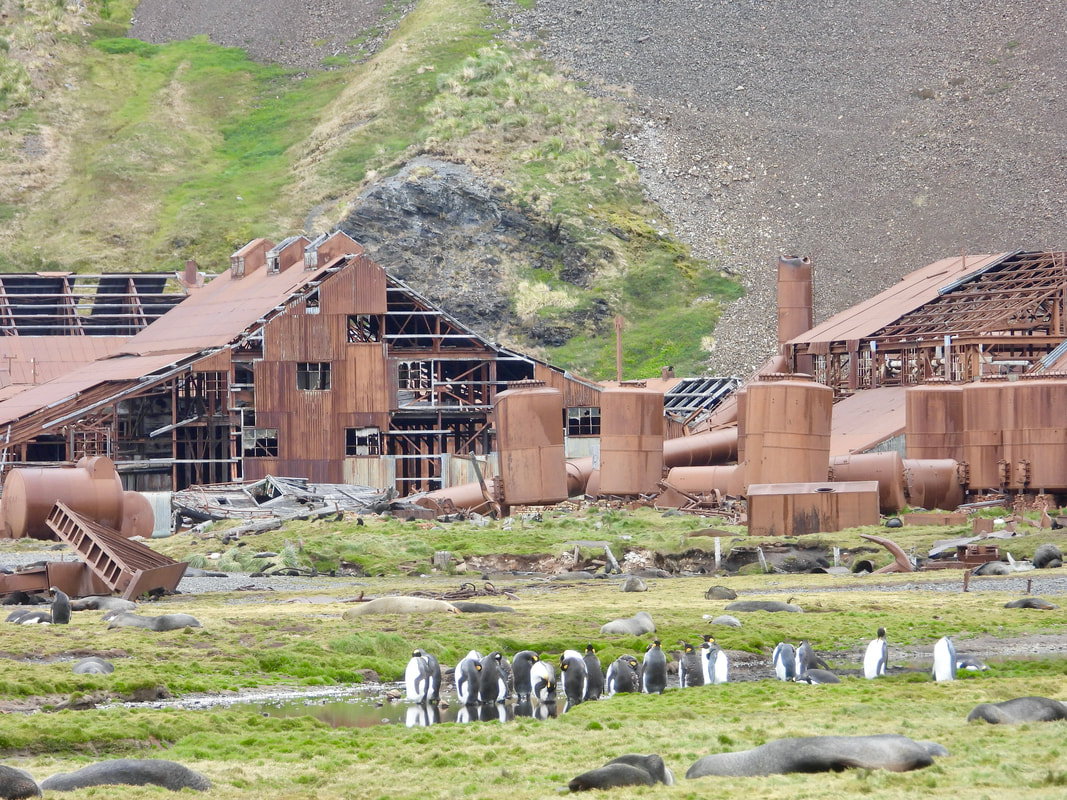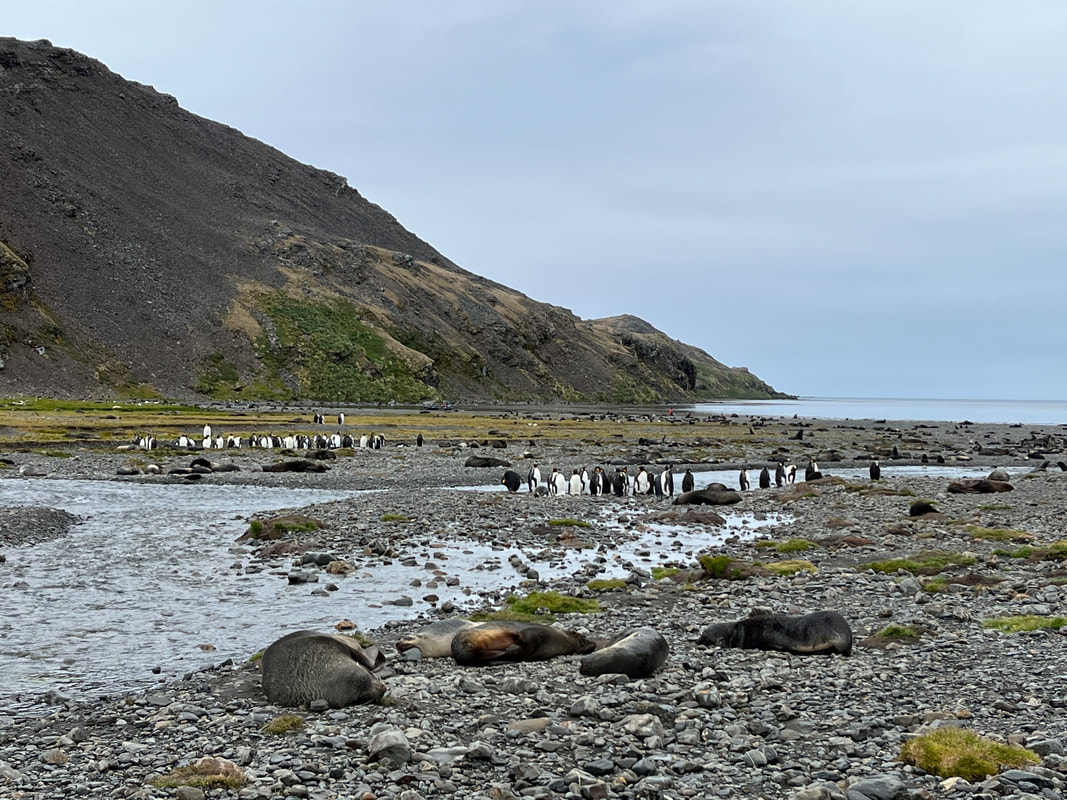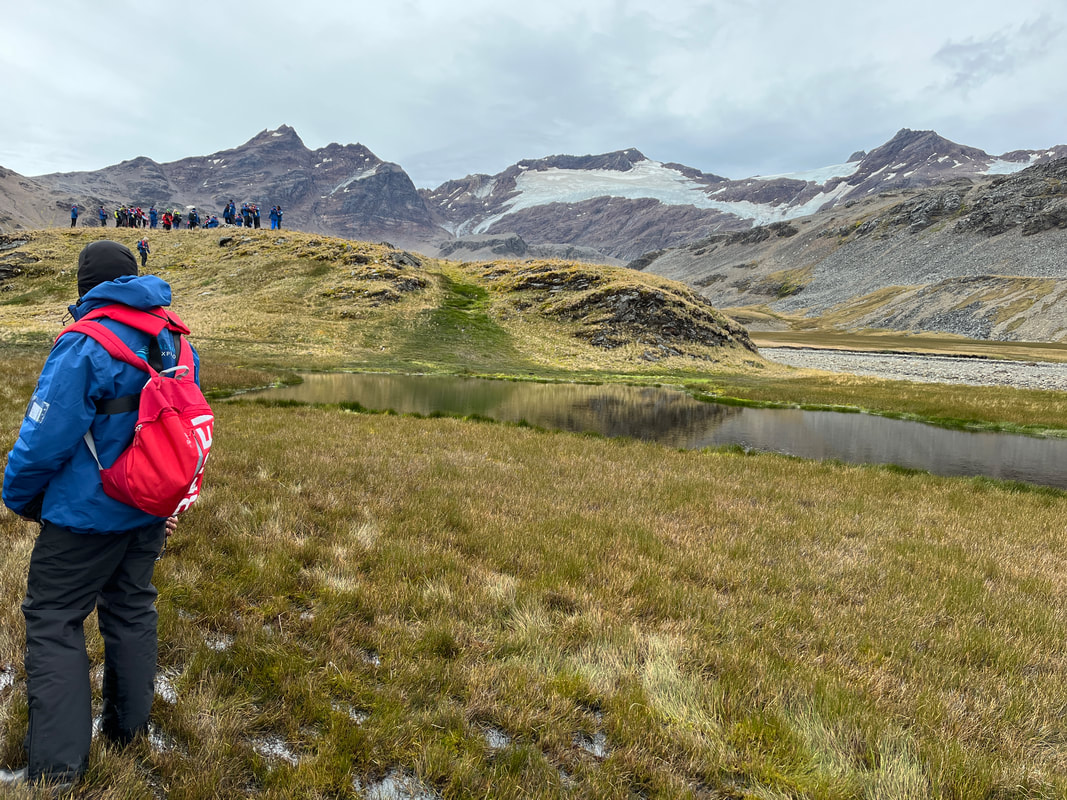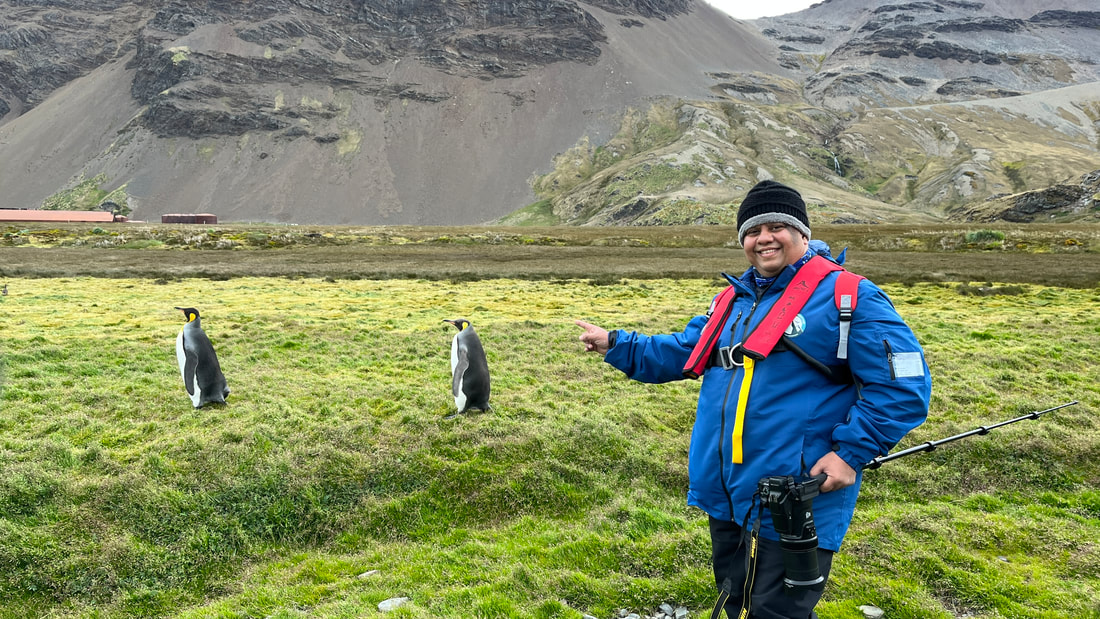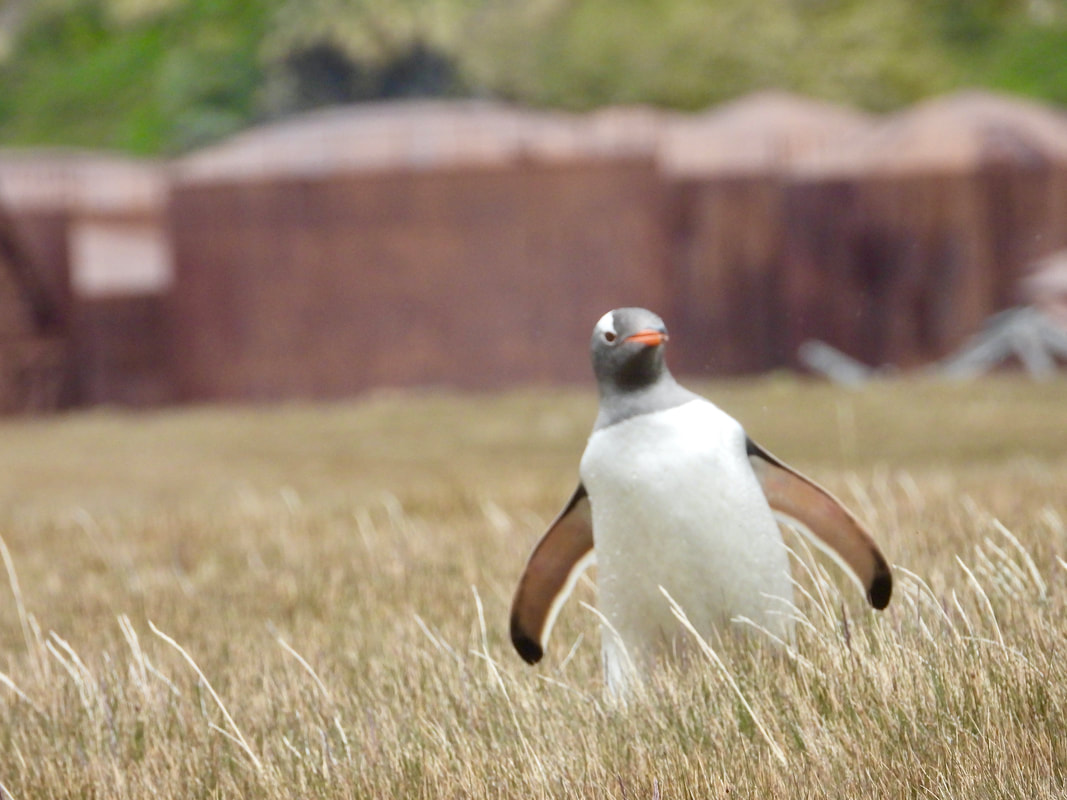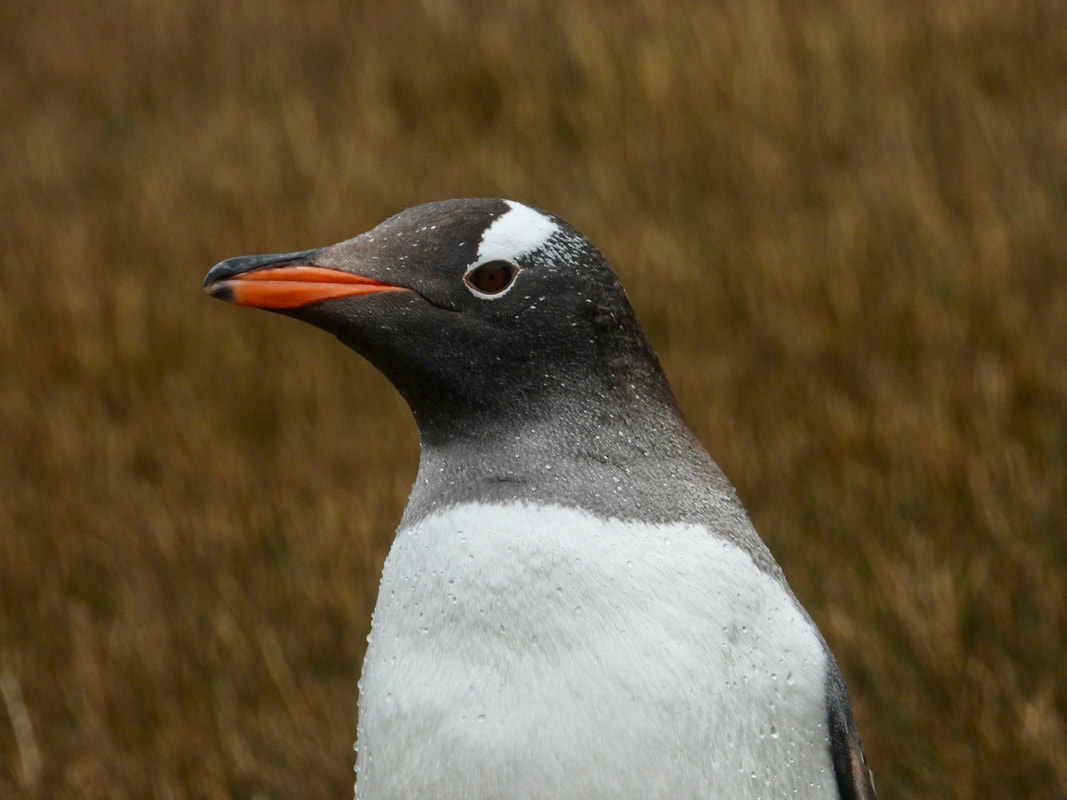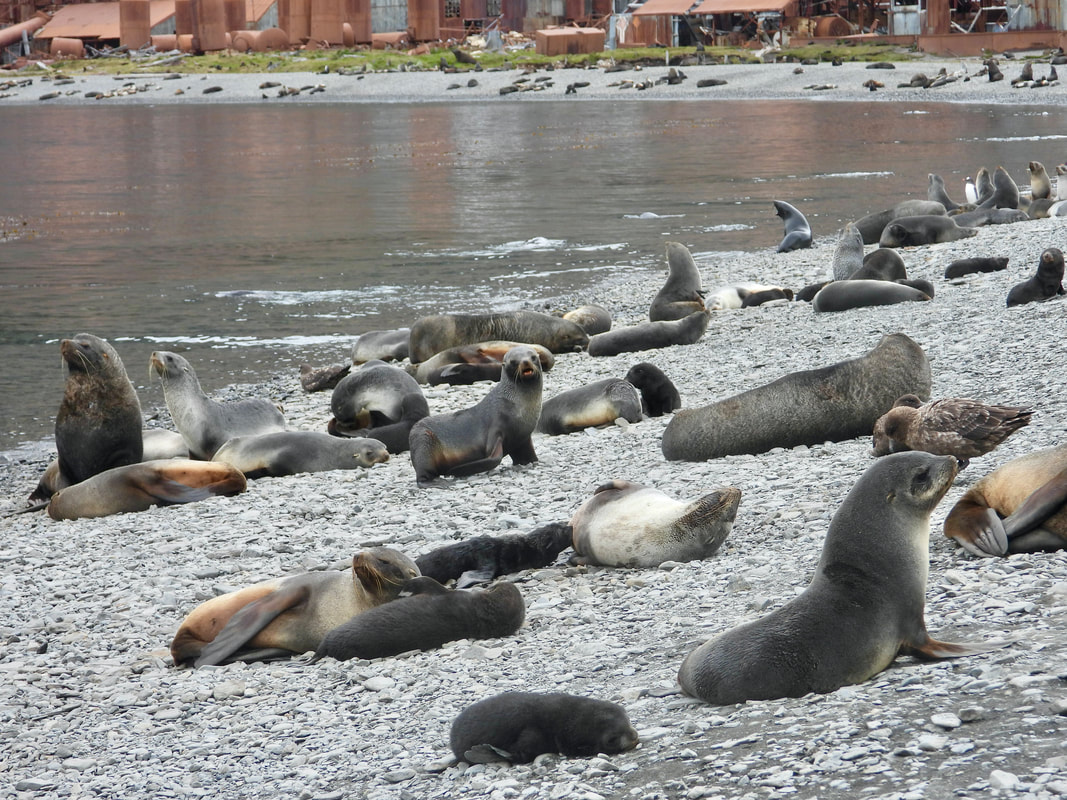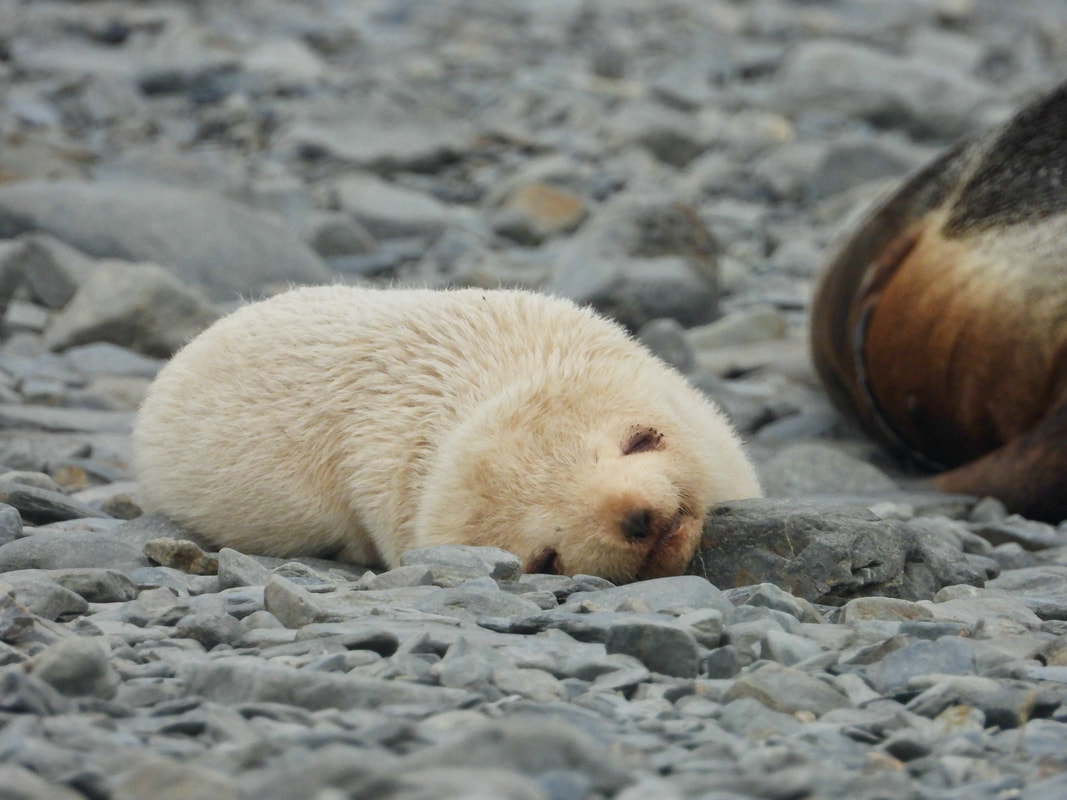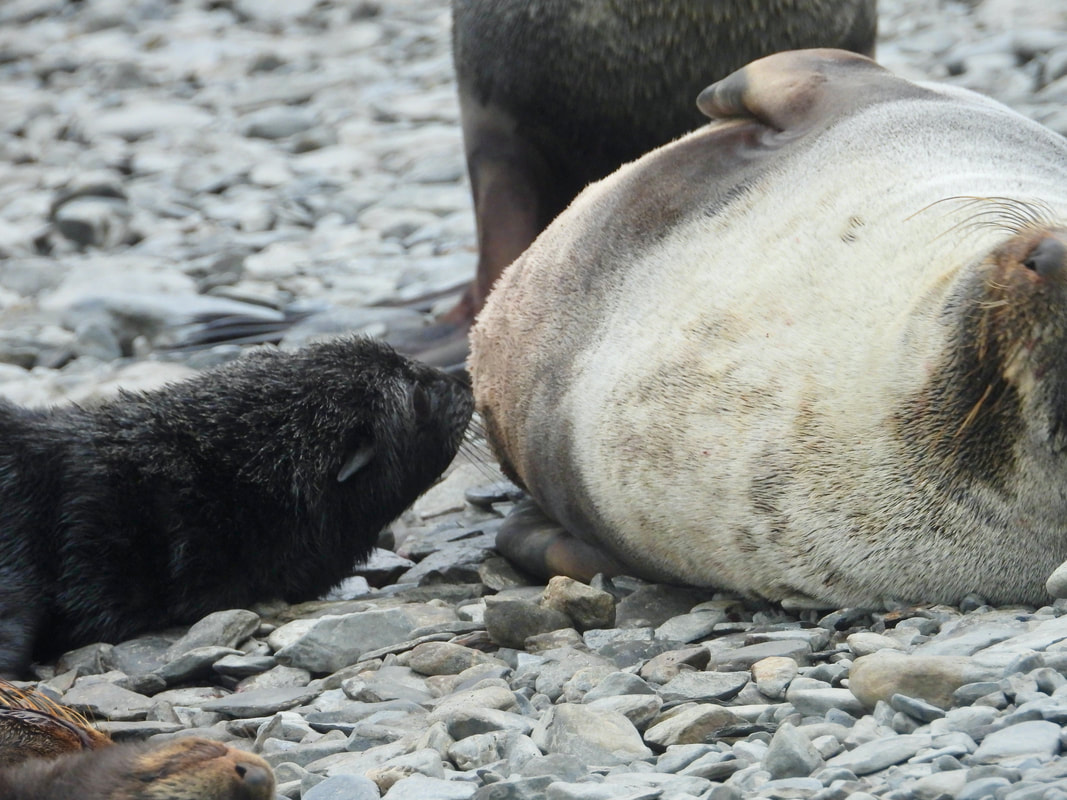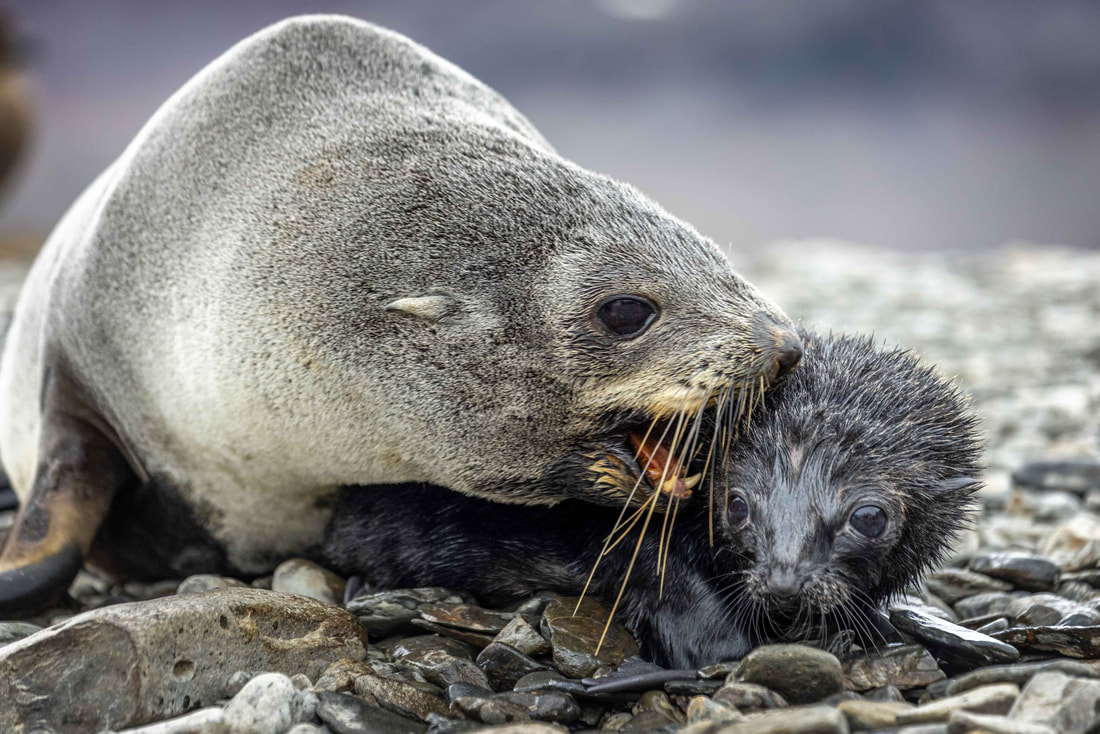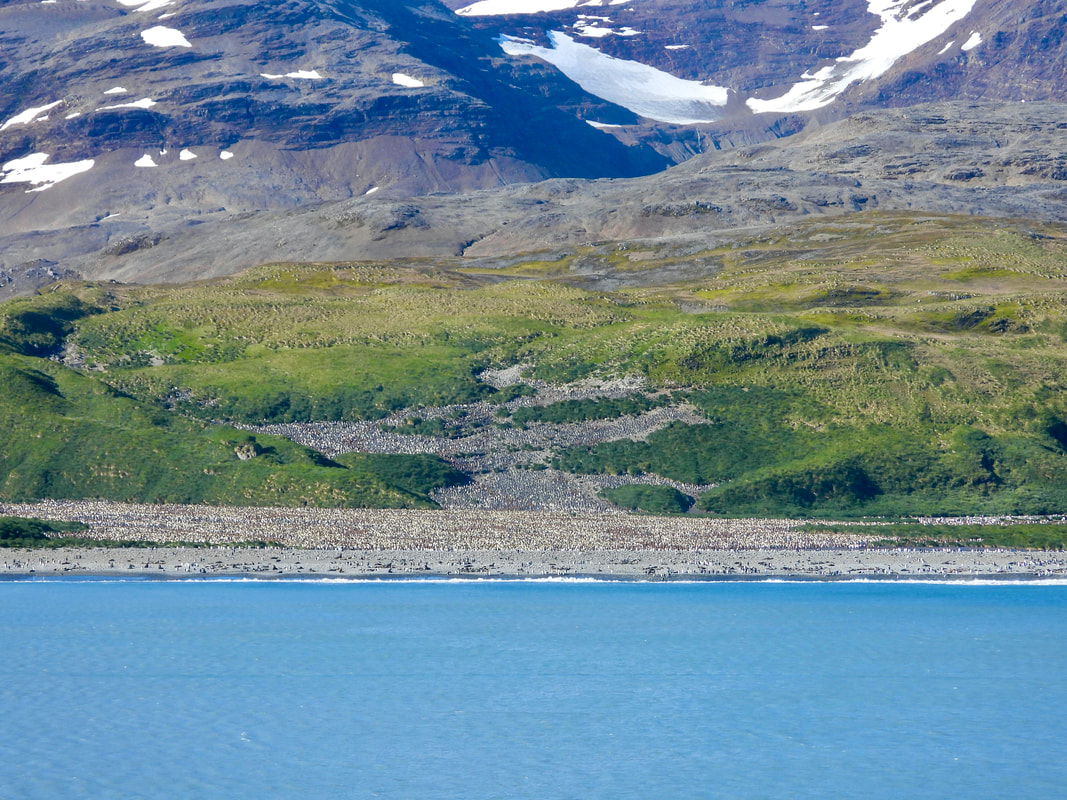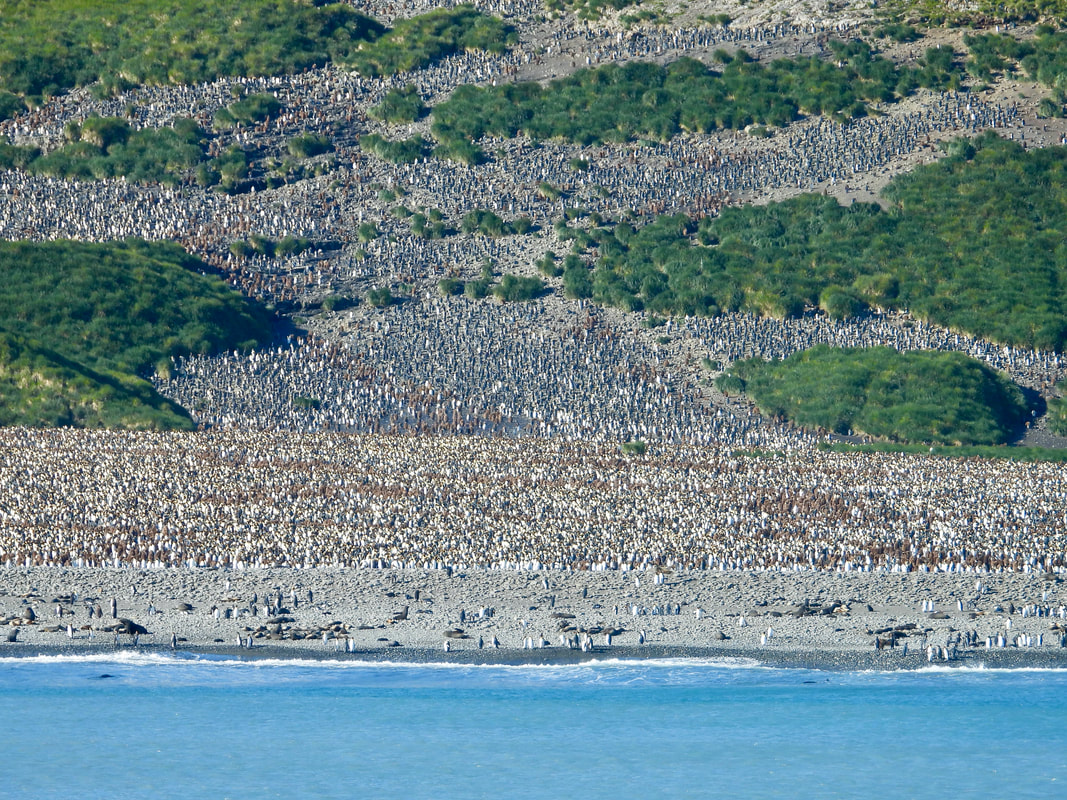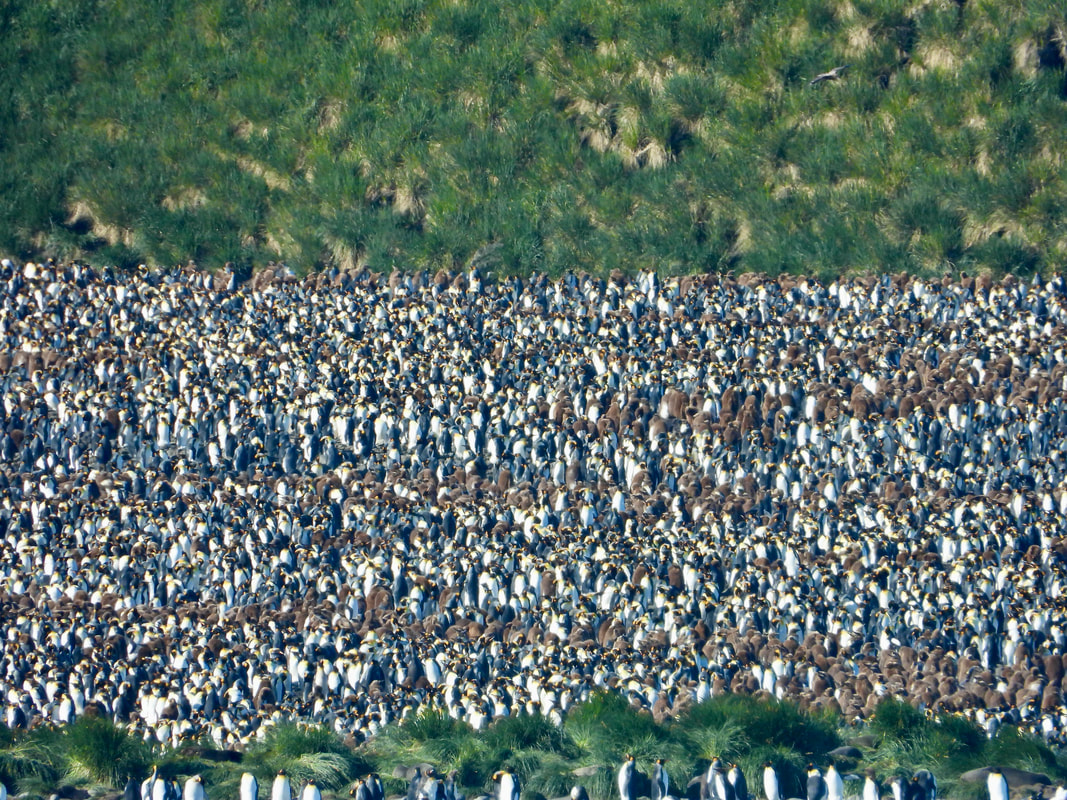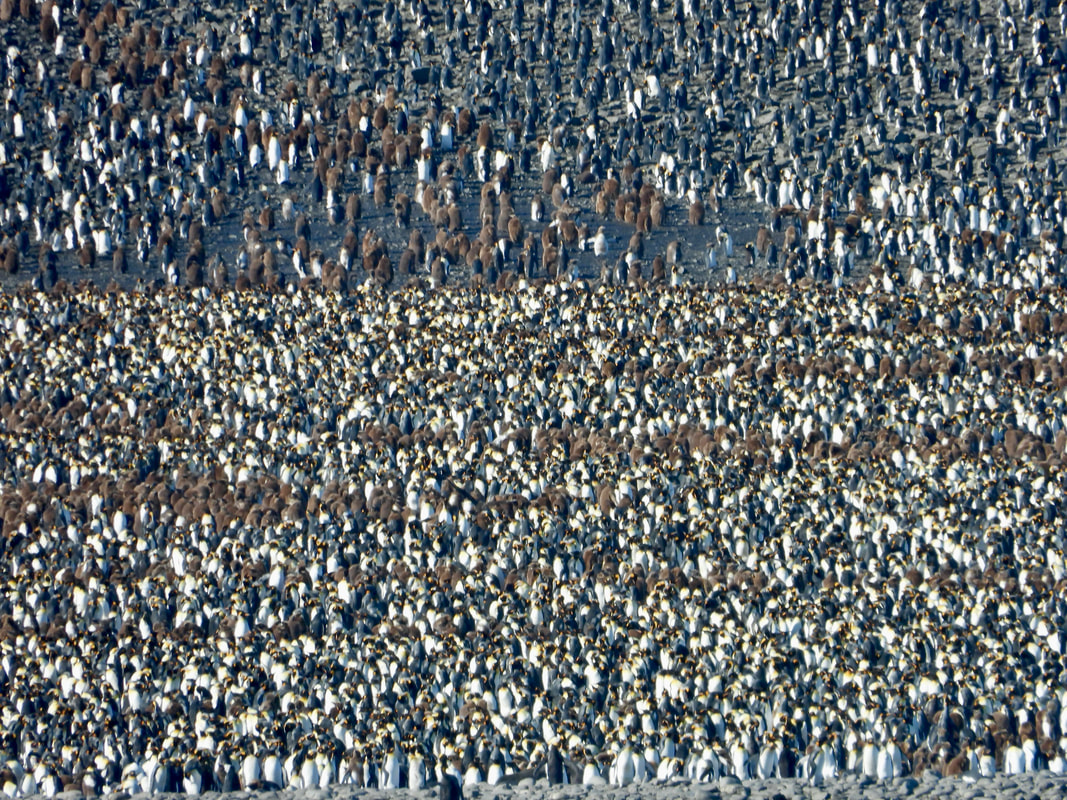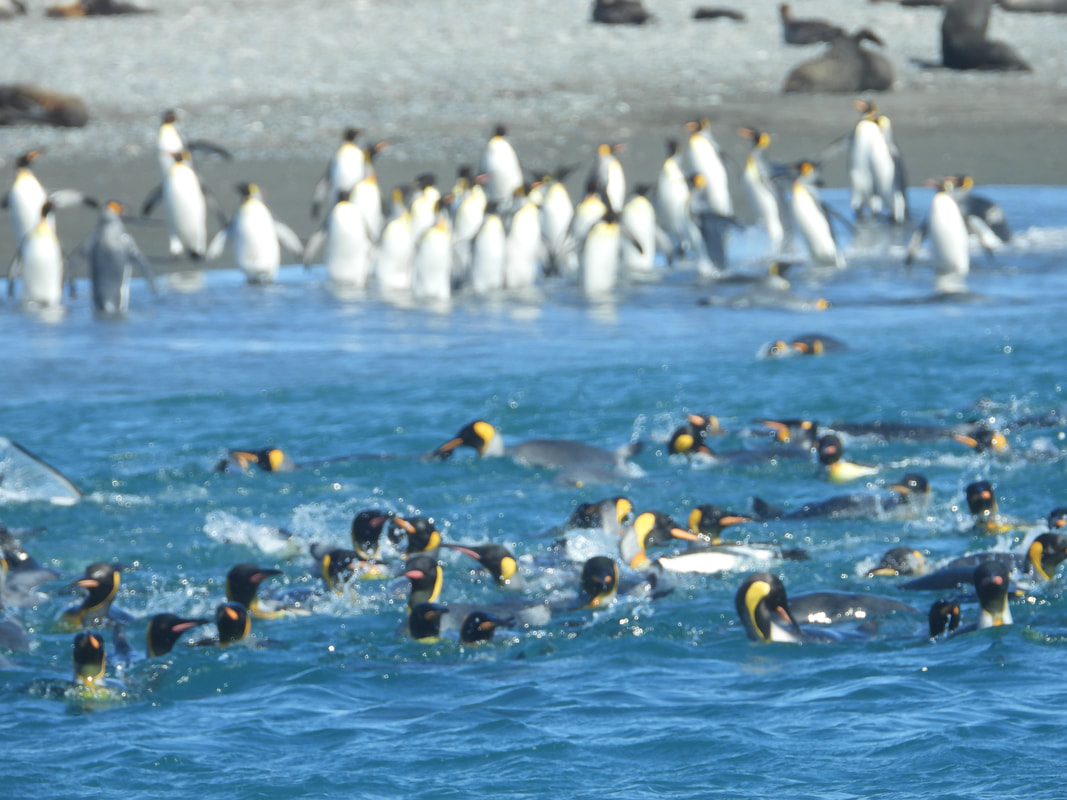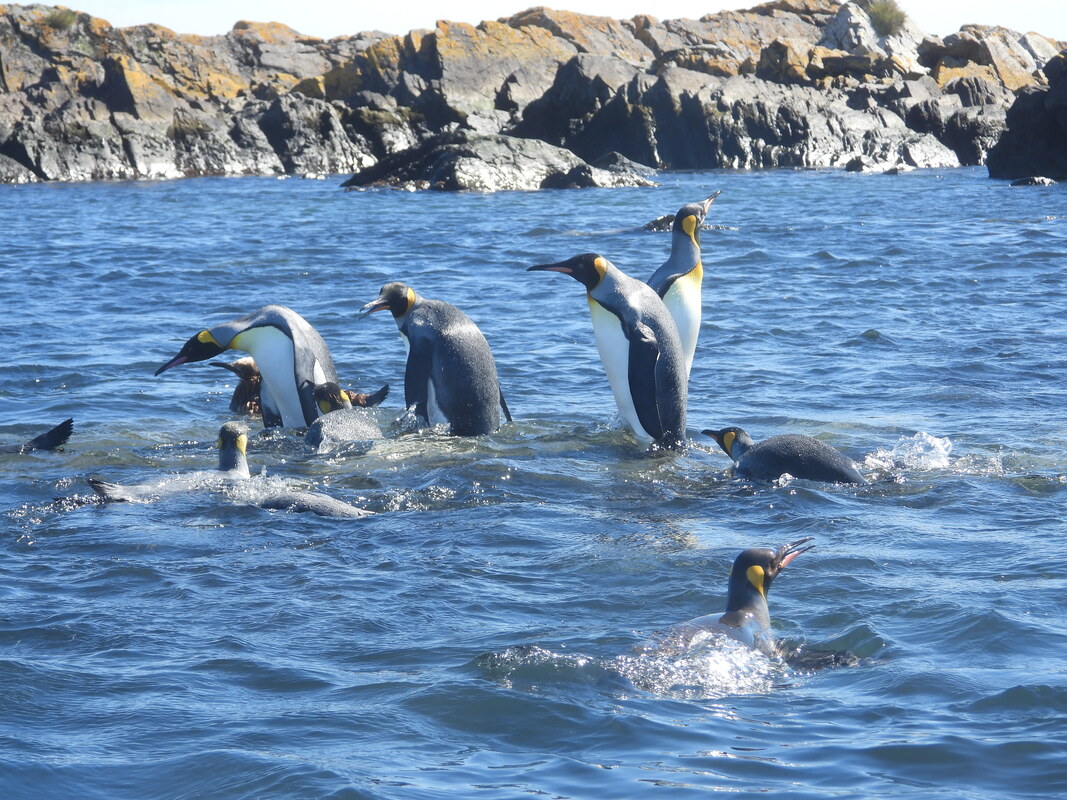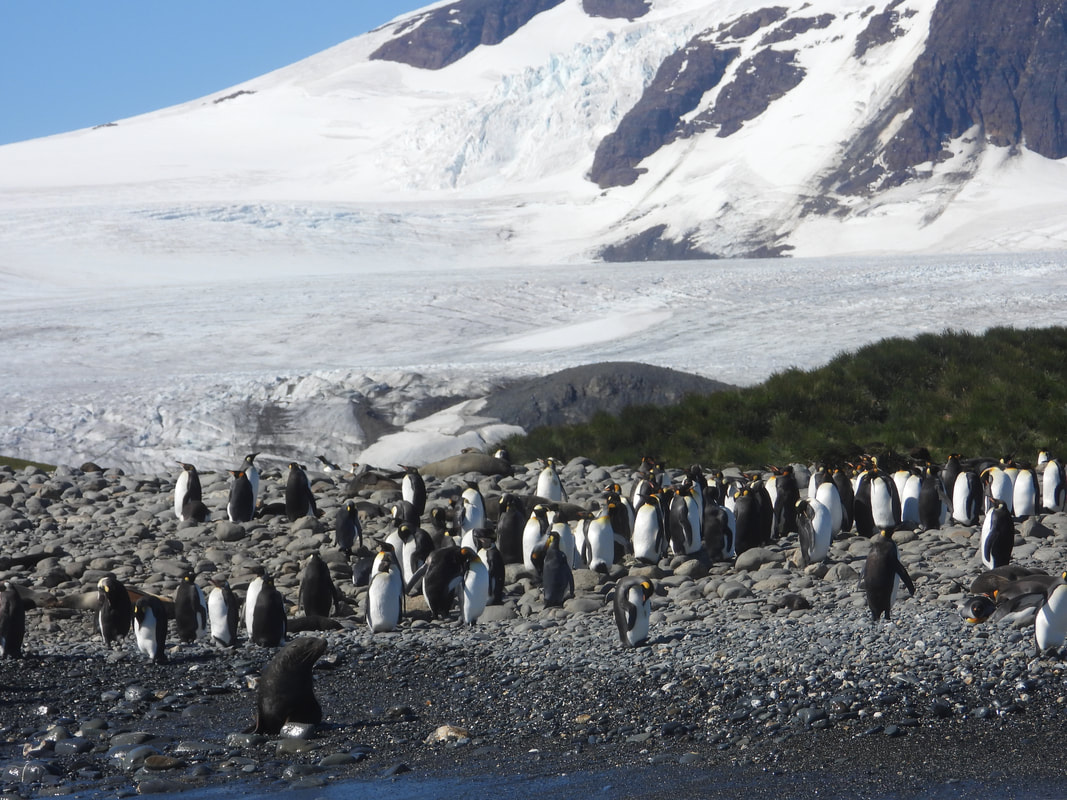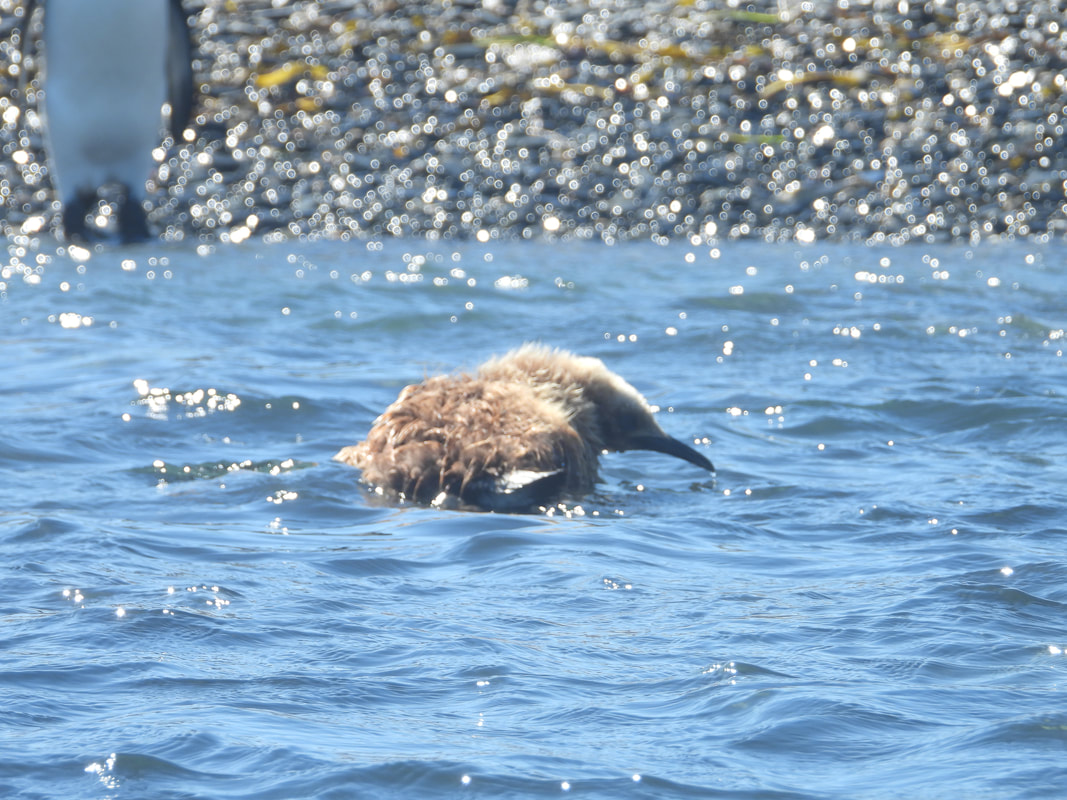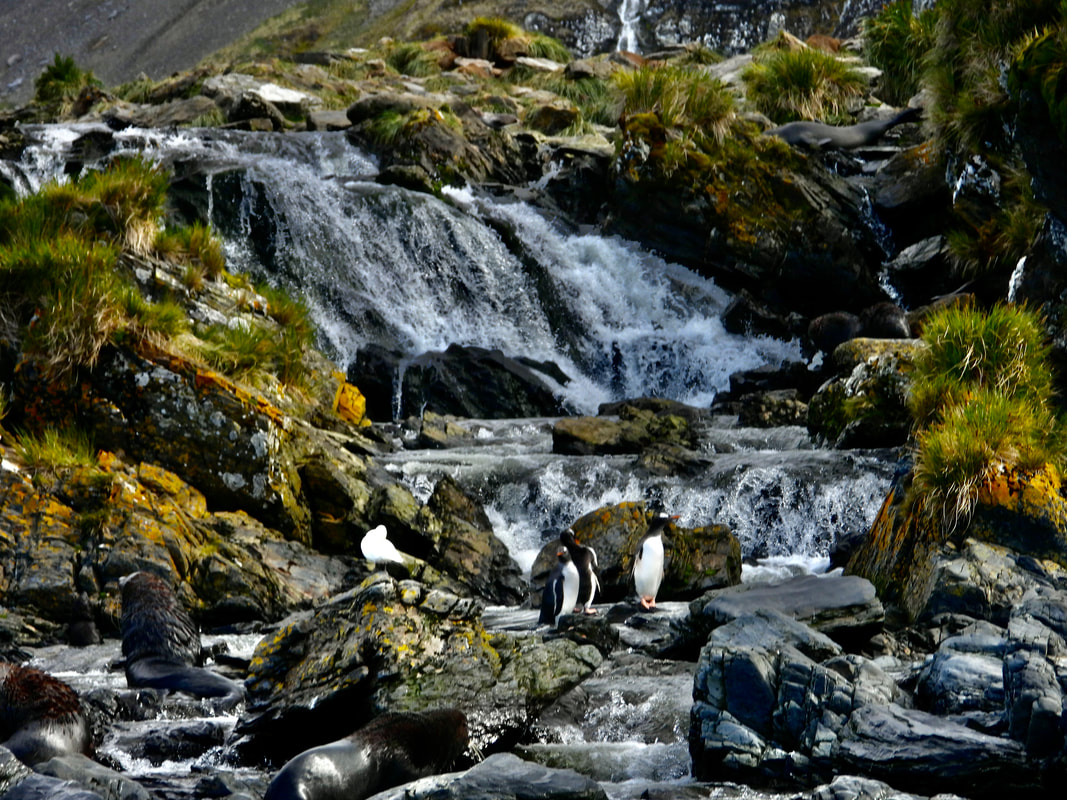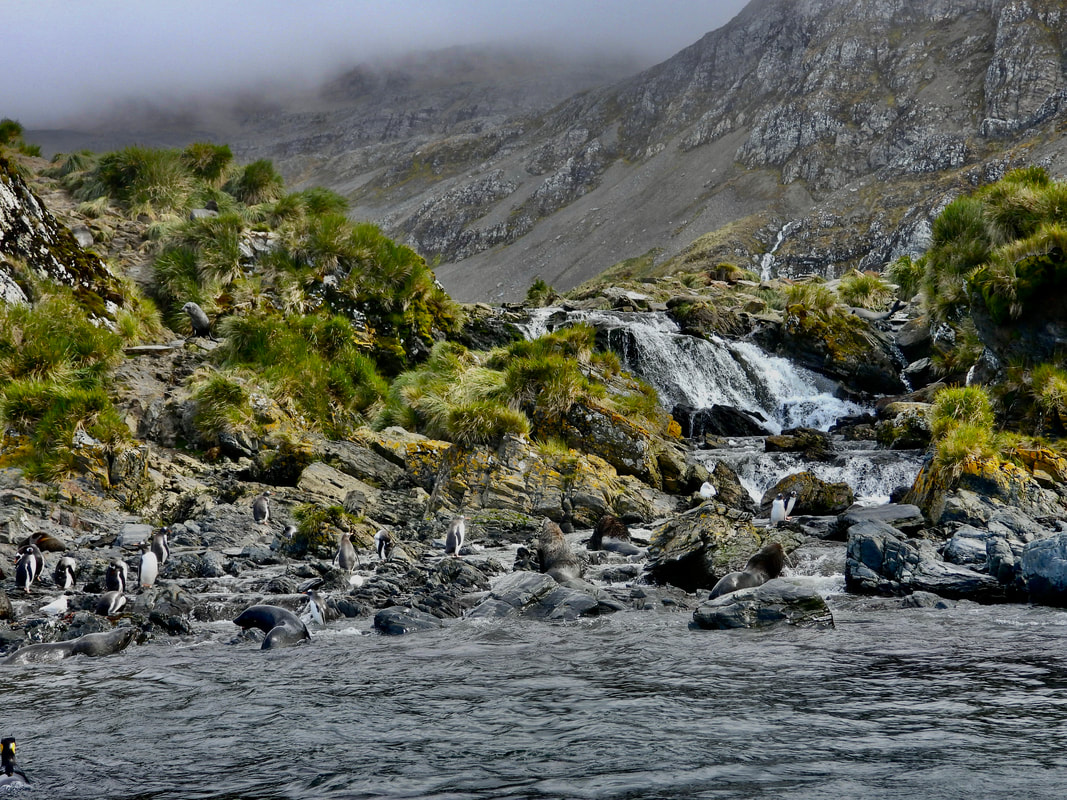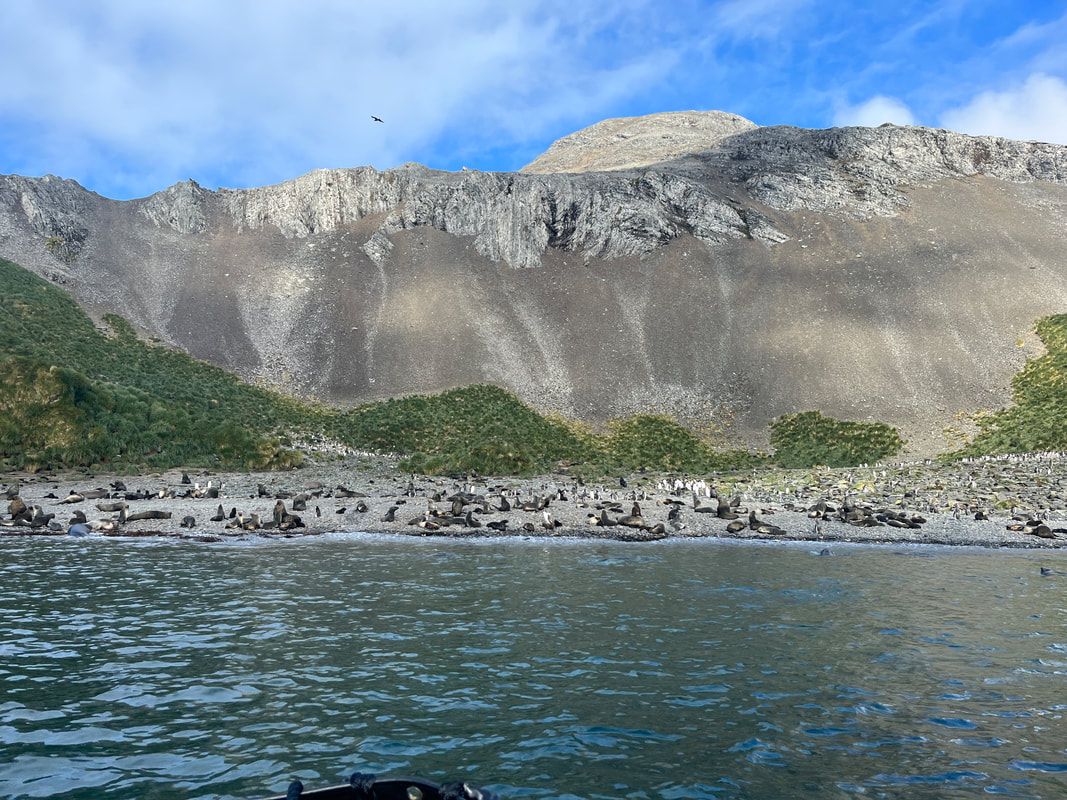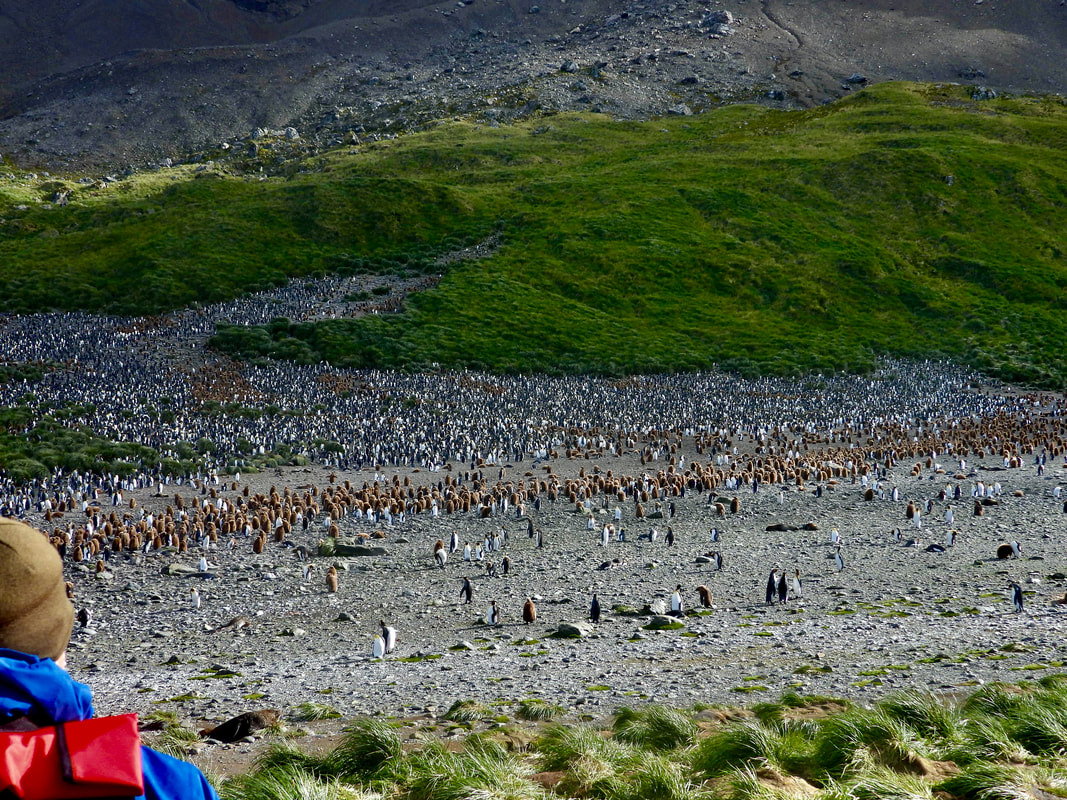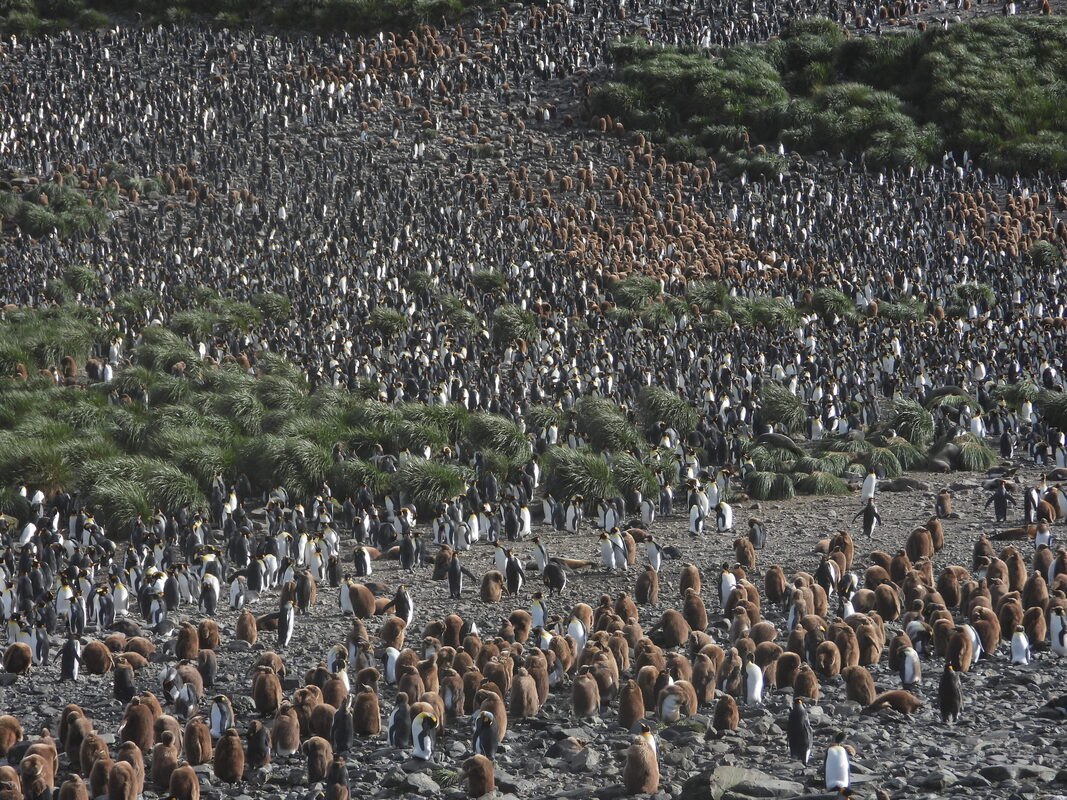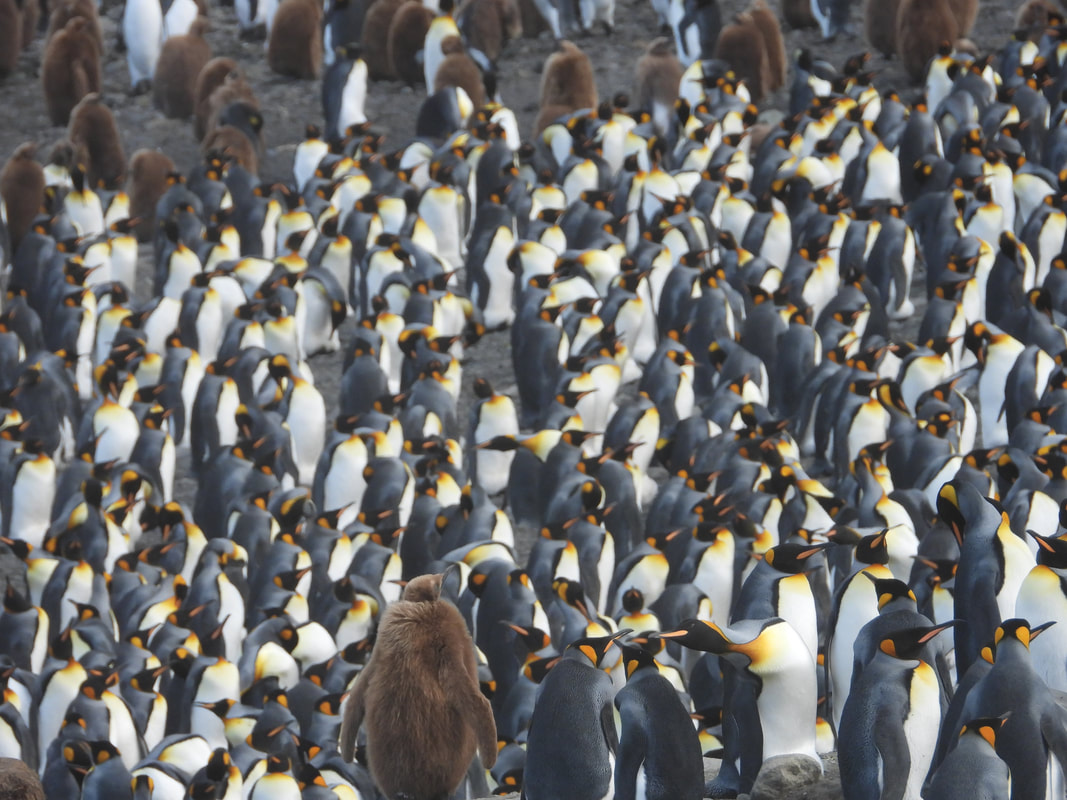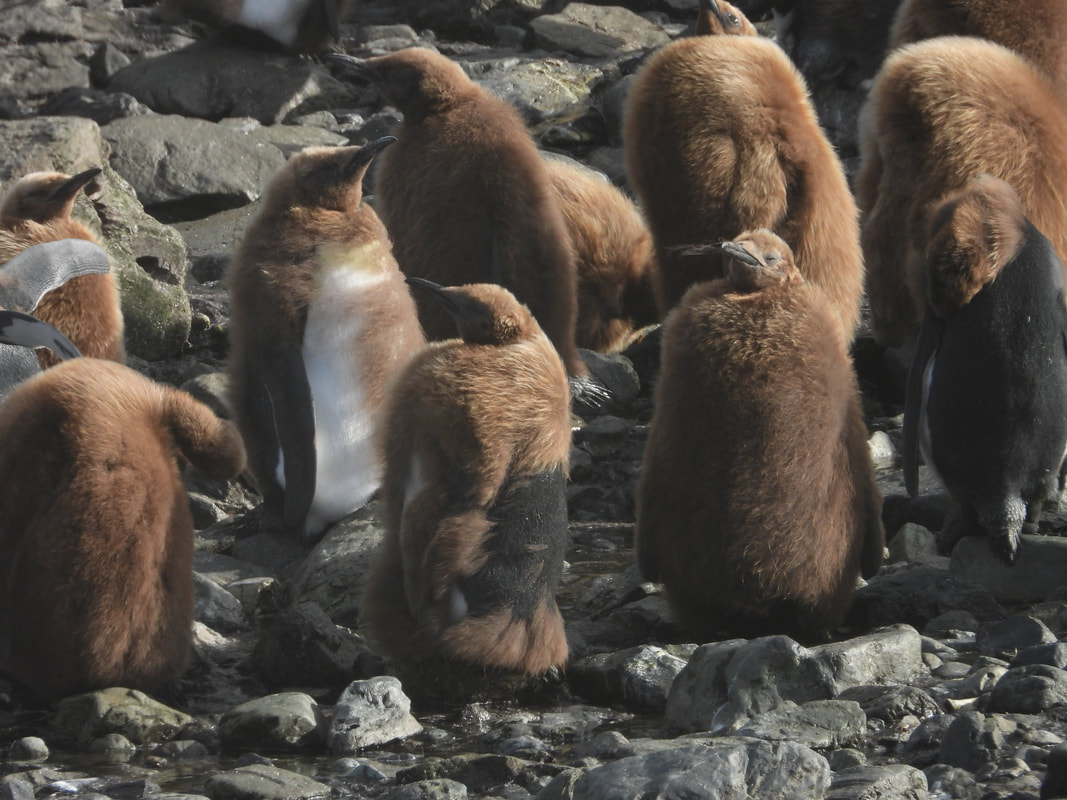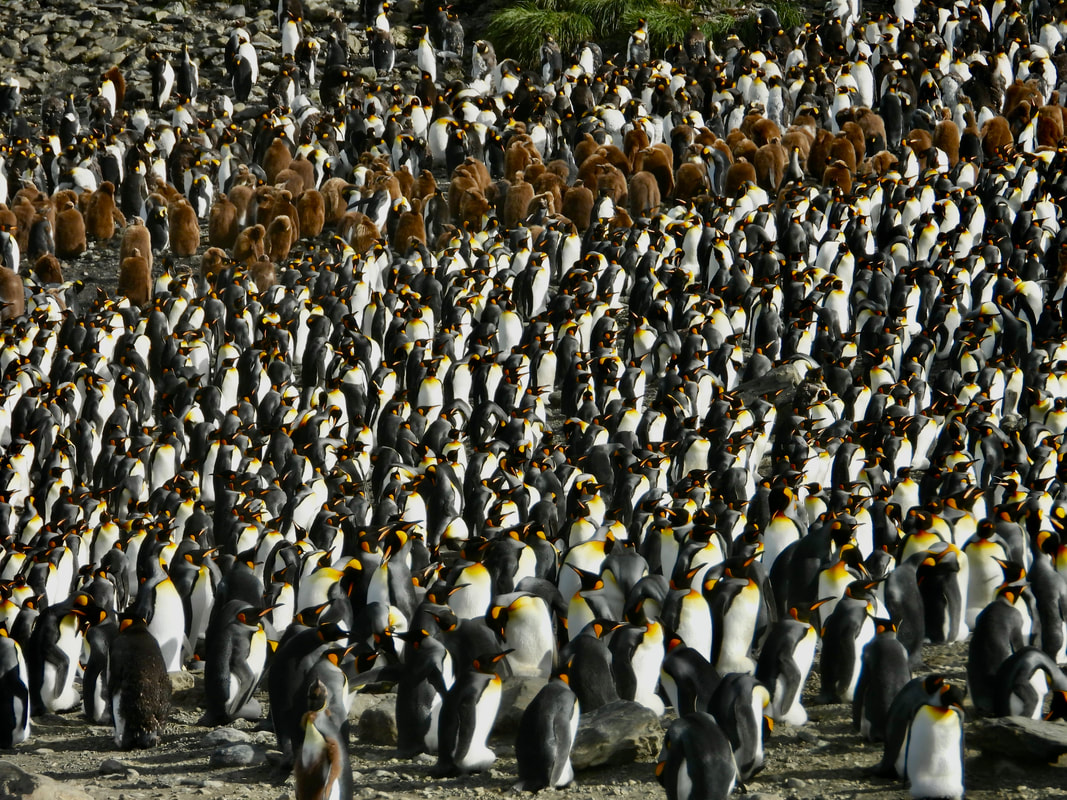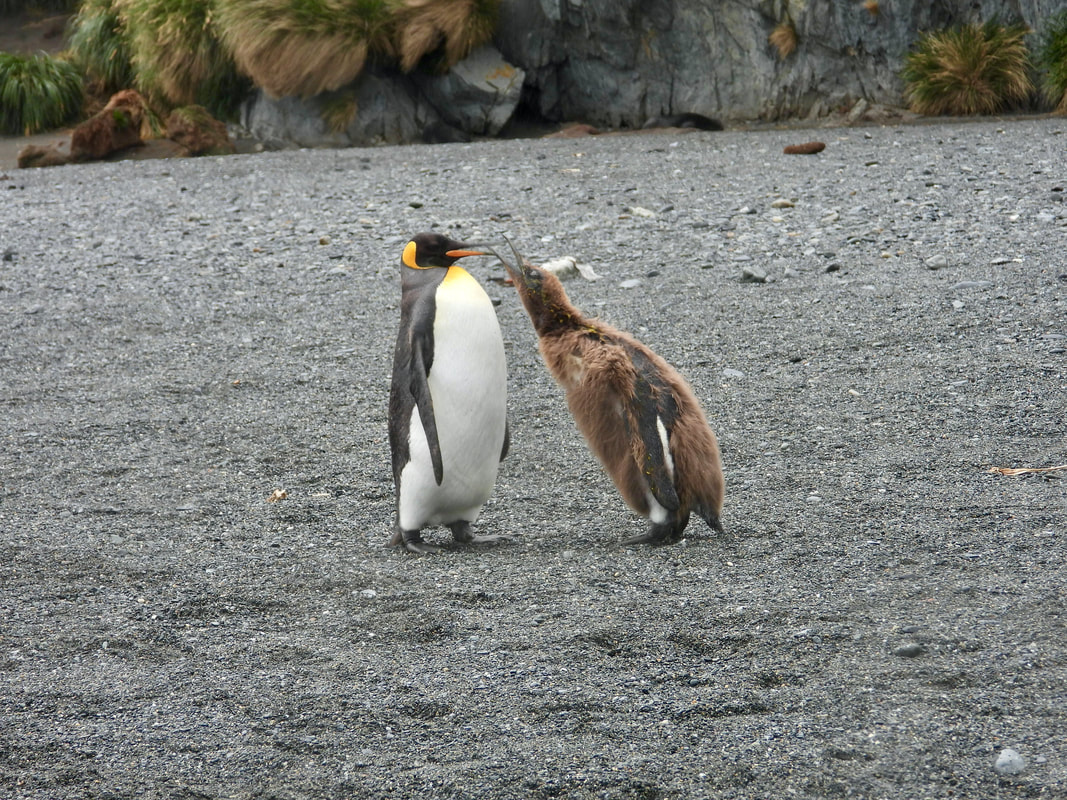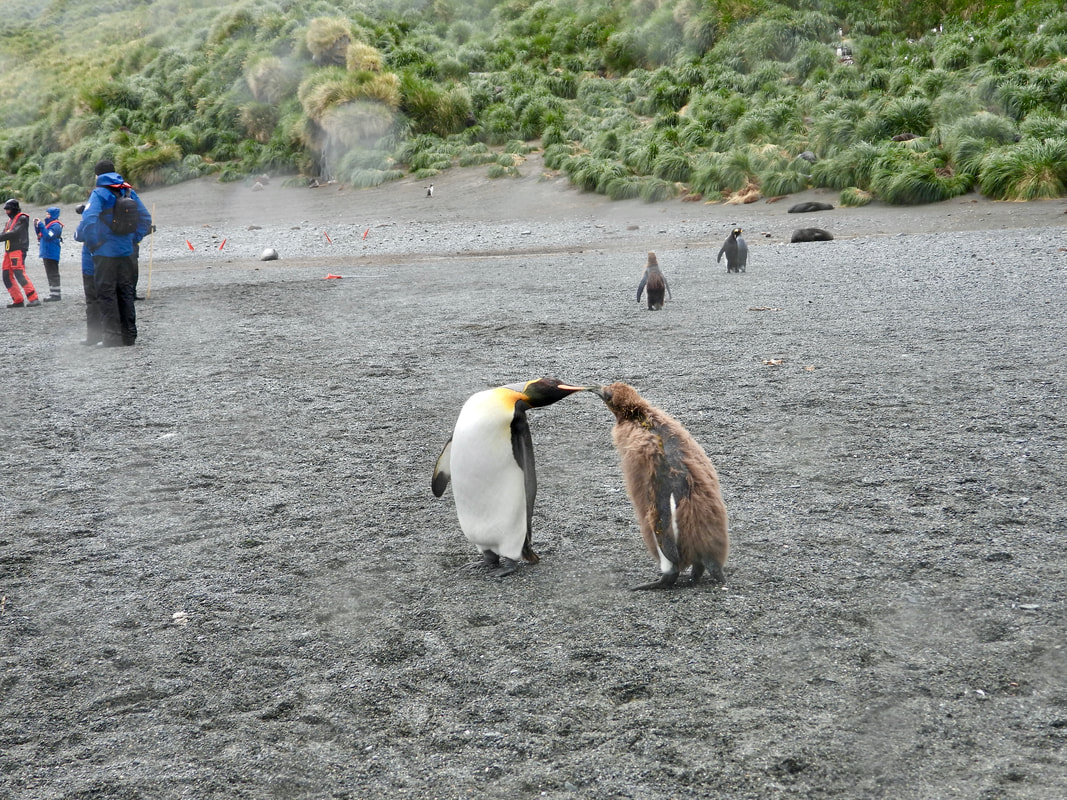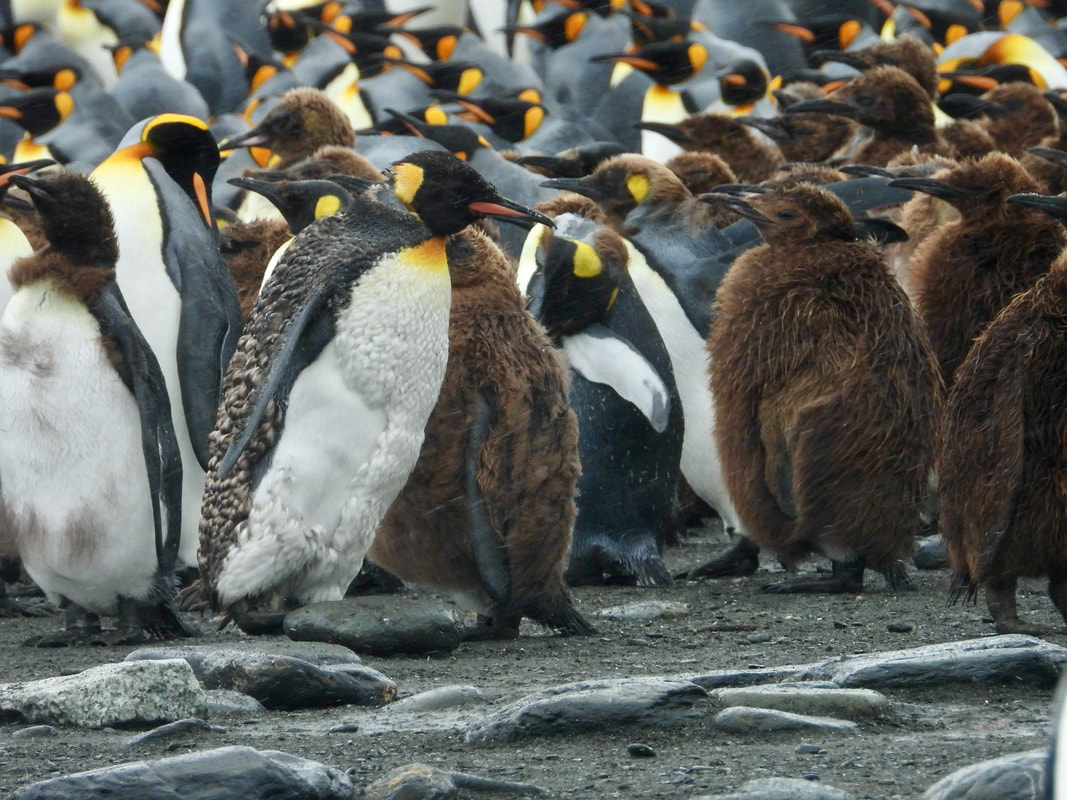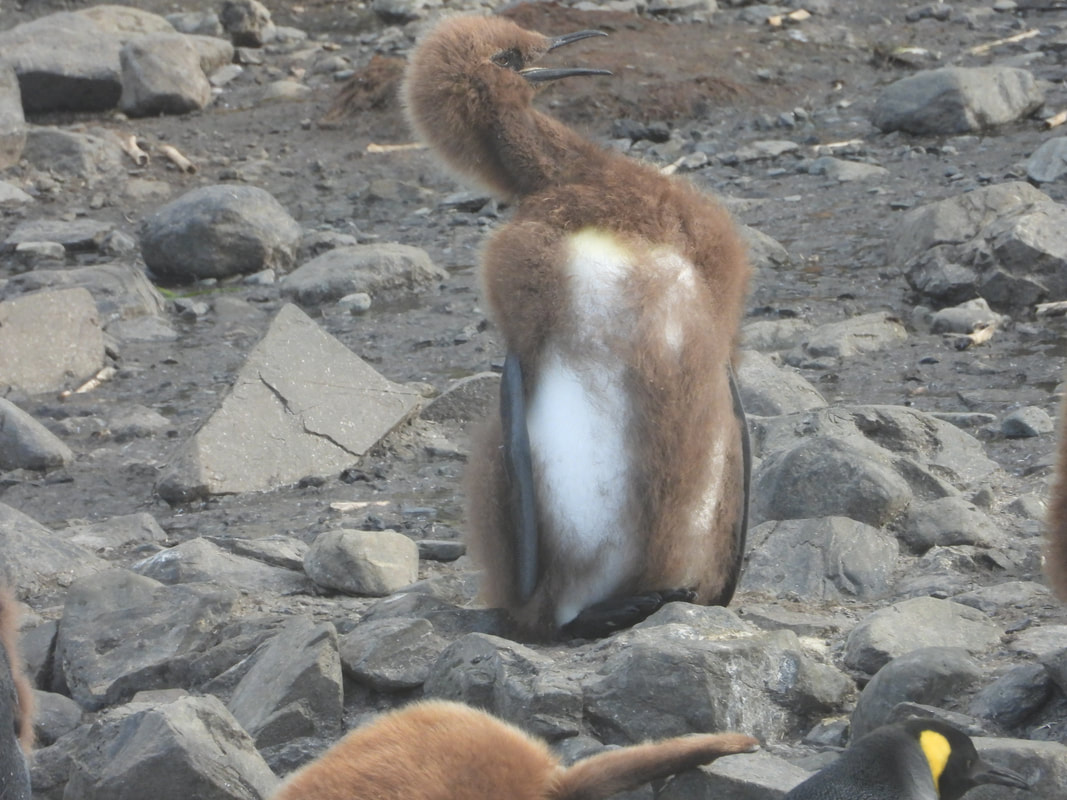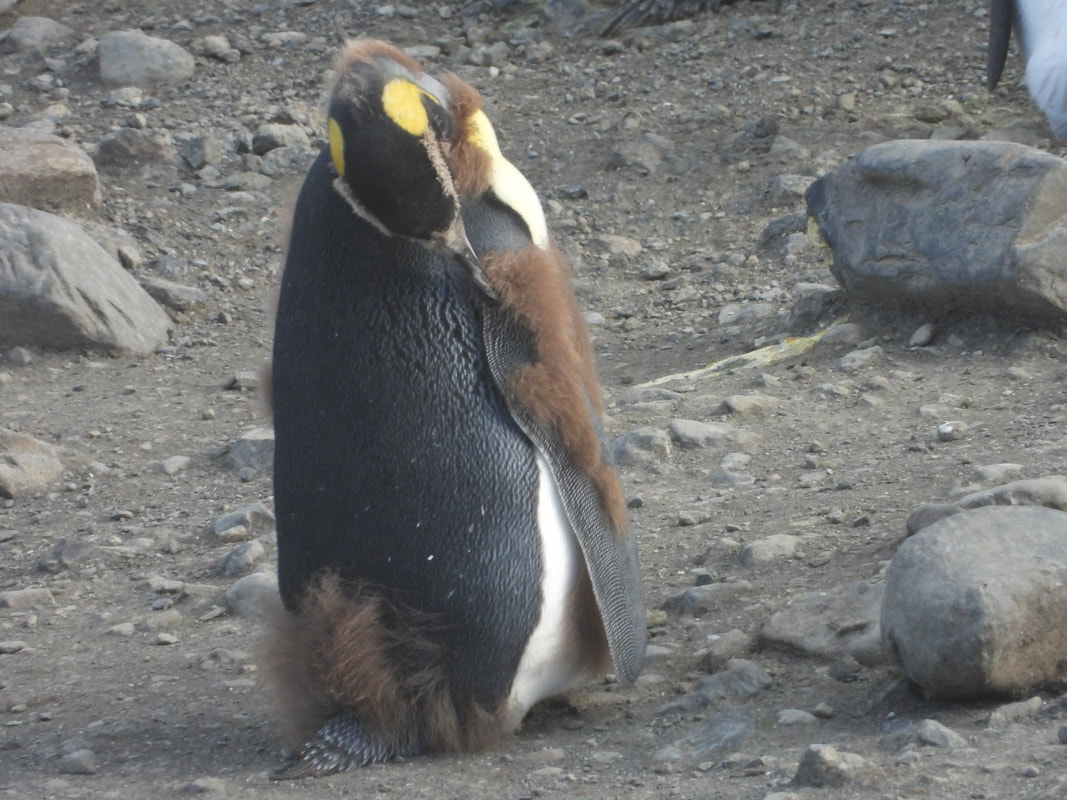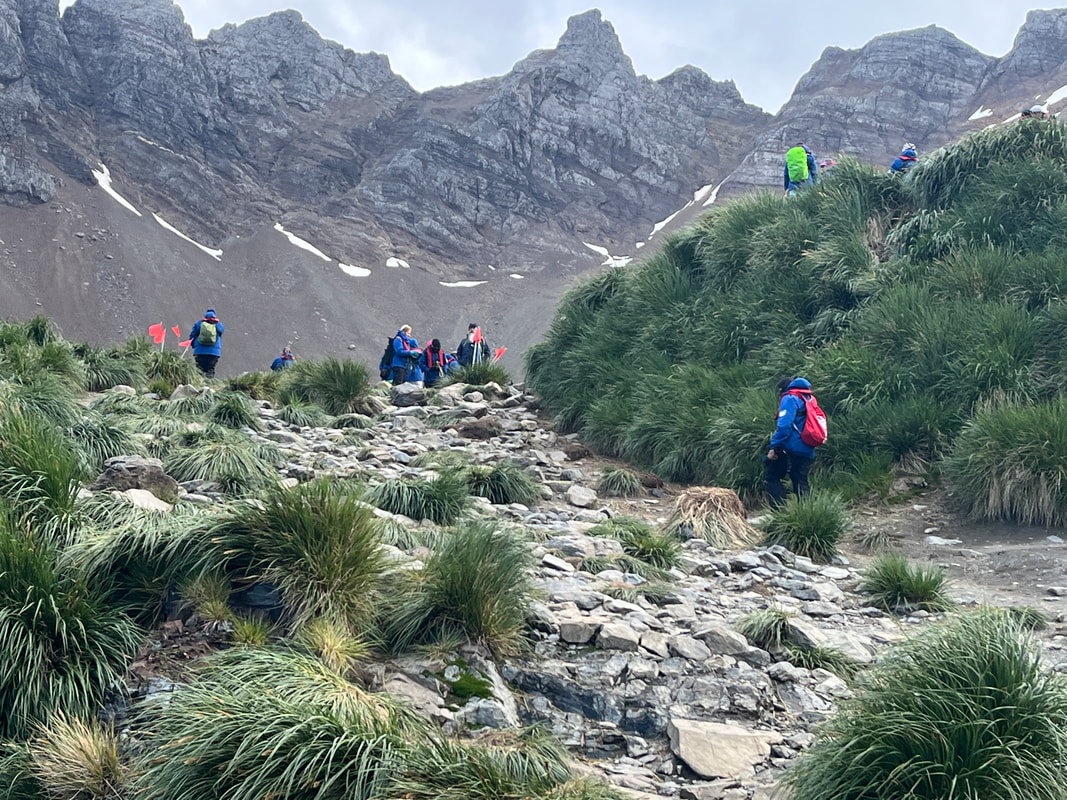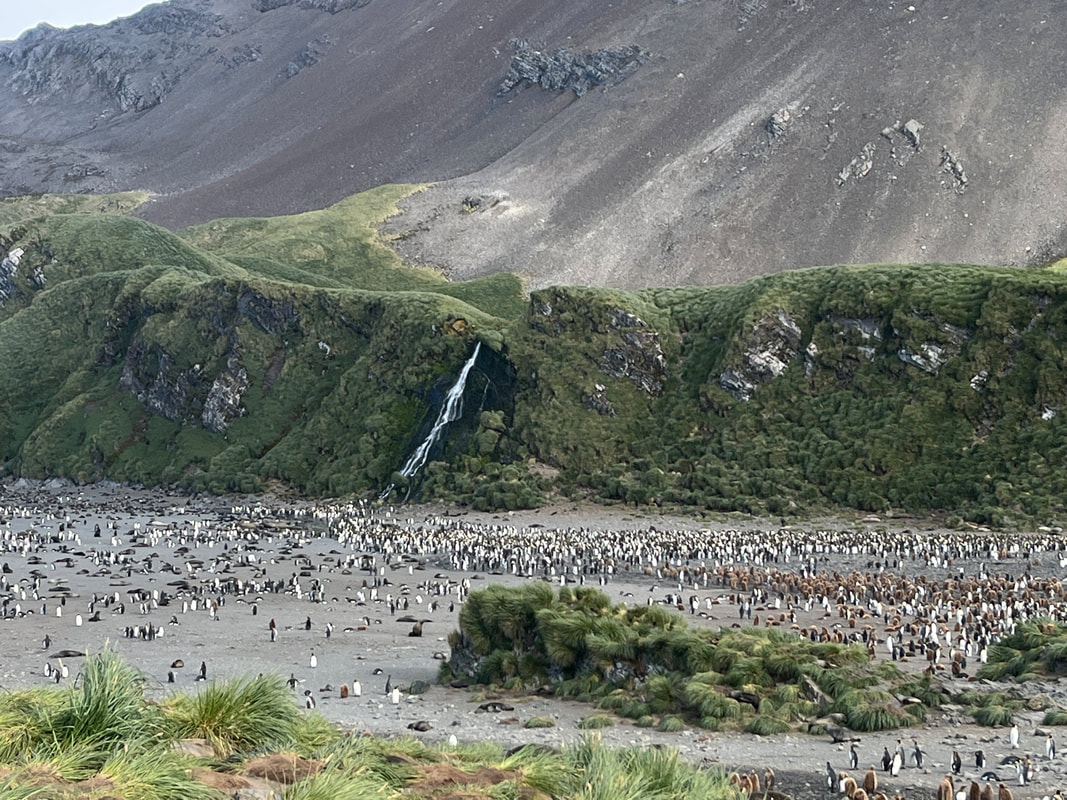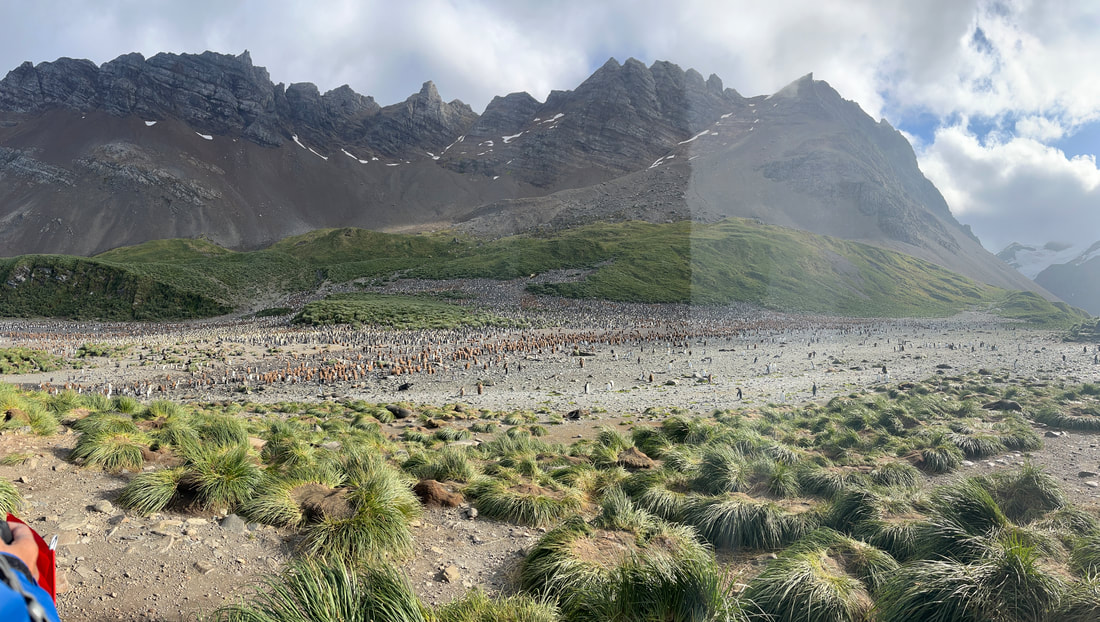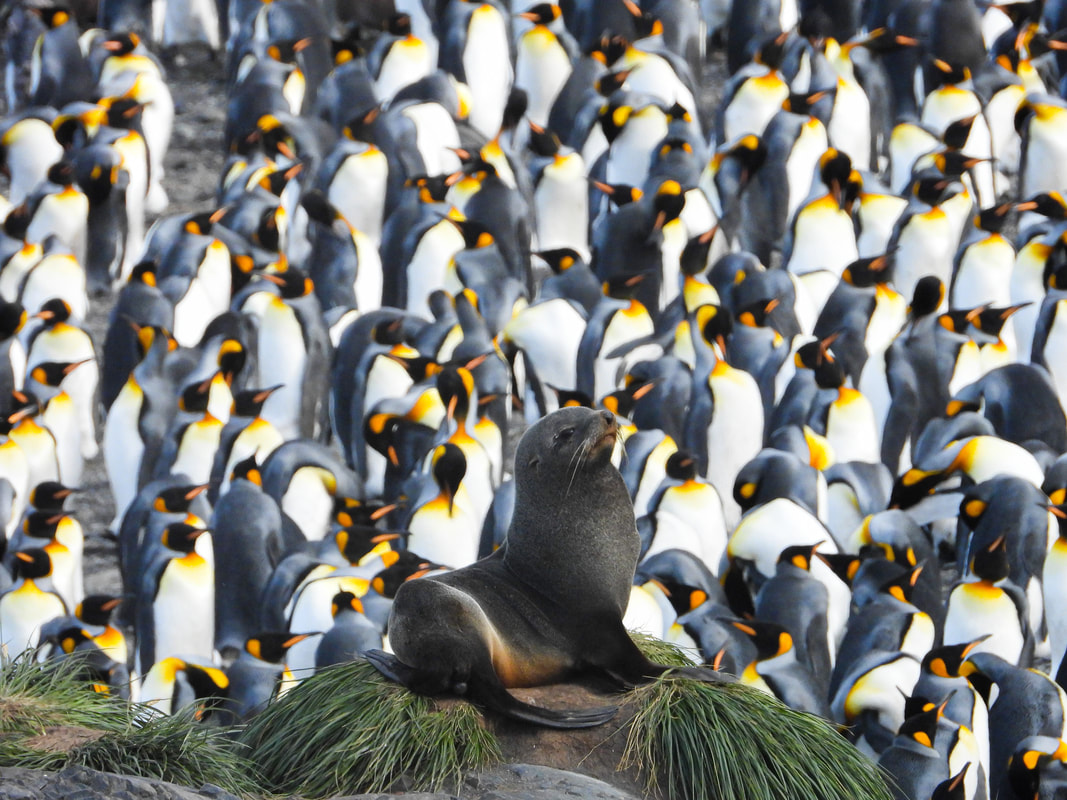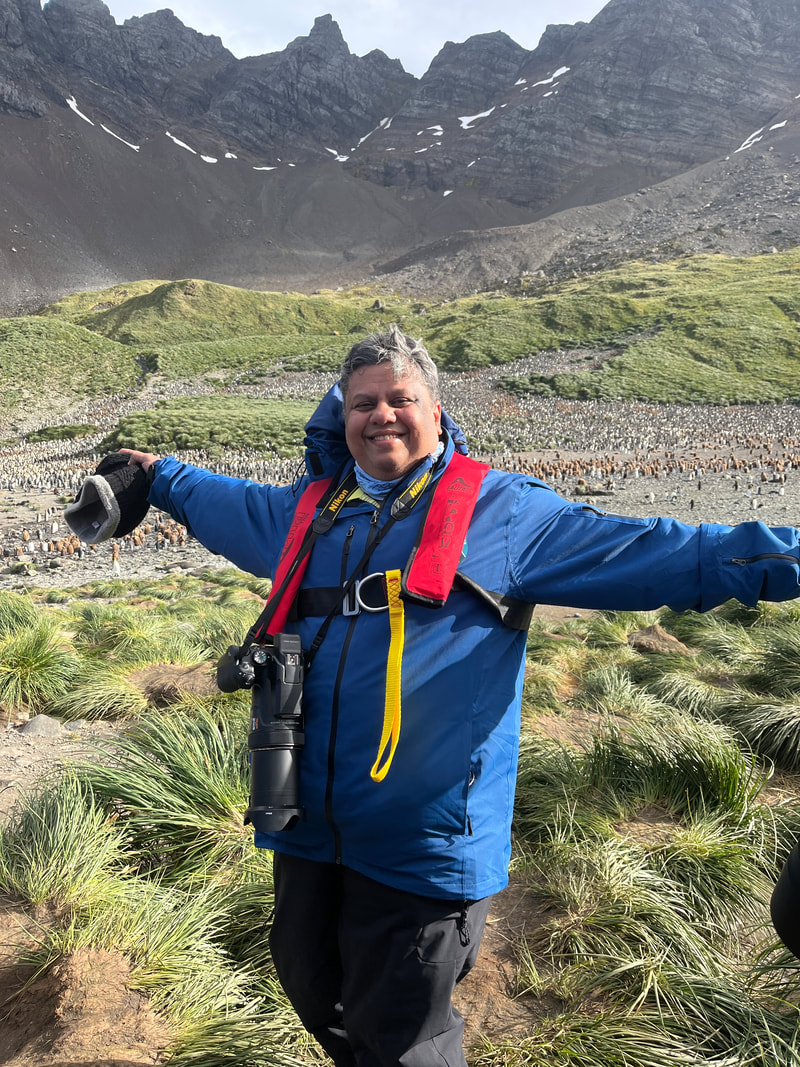Grytviken
The next morning we sailed into the protected waters of the heritage whaling community of Grytviken. This was the largest whaling station on South Georgia, in operation from 1904 to 1966. Now the station is temporality inhabited in the summer months by the museum staff.
Grytviken literally means ‘Pot bay’ … NO, NOT THAT KIND OF POT! ‘Try pots’ are basically big metal …er…pots…used by whalers to boil the whale blubber to render the fat - the whale oil. A Swedish expedition found a number of old try-pots left here by British sealers - who apparently hadn’t bothered to name the island! So, with stunning lack of originality, they named the place ‘Pot bay’.
‘Mycket bra!’ the Swedes must have said - ‘Javisst! Naming places is so much fun!’
‘Mycket bra!’ the Swedes must have said - ‘Javisst! Naming places is so much fun!’
One Norwegian called Larsen settled down here and started a whaling station for his employer - the Compañía Argentina de Pesca (Argentine Fishing Company) - and got busy butchering whales. The whalers used every part of the animals – the blubber, meat, bones and viscera were rendered to extract the oil, and the bones and meat were turned into fertiliser and fodder. Elephant seals were also hunted for their blubber. Around 300 men worked at the station during its heyday, operating during the southern summer from October to March. A few remained over the winter to maintain the boats and factory. Every few months a transport ship would bring essential supplies to the station and take away the oil and other produce.
They assembled a factory here to process all the whale products.The factory was built in Europe and brought here in pieces by ship, and reassembled like a giant Ikea set.
I looked at the remains of the factory and was impressed! It was pretty huge and impressive even in this old and rotting avatar. Imagine putting up this huge thing in just a month! Crazy!
They assembled a factory here to process all the whale products.The factory was built in Europe and brought here in pieces by ship, and reassembled like a giant Ikea set.
I looked at the remains of the factory and was impressed! It was pretty huge and impressive even in this old and rotting avatar. Imagine putting up this huge thing in just a month! Crazy!
Grytviken was of course immortalised by the adventures of Shackleton, as we mentioned earlier. Shackleton staggered in here, muddy and wet and three-quarters dead, and must have startled the whalers considerably! After recovering with some much-needed booze and reindeer steak, Shackleton organised a rescue operation to bring home the remaining men, with the help of the whalers and their ships. The Shackleton party survived only due to the presence of these whalers!
Shackleton returned to Grytviken for a third shot at Antarctica - but never left the place! He had a heart attack and died on this island! His widow decided that he should be buried there itself, because he loved Antarctica so much.
His grave is located south of Grytviken, alongside those of whalers who had died on the island.
Shackleton returned to Grytviken for a third shot at Antarctica - but never left the place! He had a heart attack and died on this island! His widow decided that he should be buried there itself, because he loved Antarctica so much.
His grave is located south of Grytviken, alongside those of whalers who had died on the island.
We went to the pretty cemetery to see his grave, which is well marked and honoured with a large commemorative slab. It’s not a polished fancy thing - it’s a raw granite slab, to show the raw strength of the man. The front bears a nine-pointed star, a symbol associated with the Shackleton family; the reverse a quotation from Robert Browning ‘I hold that a man should strive to the uttermost for his life’s set prize’.
There is a pretty little museum there, housed in what used to be the villa of the manager of the station. It actually started as a specialised whaling museum, but then it expanded its expositions to include all aspects of the discovery of the island, sealing industry, whaling, maritime and natural history, as well as the 1982 Falklands war. They have kinds of interesting stuff here - including a cross-section of penguin’s coat ( which shows you how deep and dense the feathers are! No wonder it can stand these temperatures with ease!), a seal fur, a foetus of a whale, various whale bones and all kinds of instruments used to kill and cut up whales.
There is a very pretty church here too - The Norwegian Anglican Church, also known as the Whalers Church. It was a wooden church - and this was also pre-built in Norway and brought here in pieces, and erected IKEA- style around 1912–1913. (No wonder IKEA is a scandinavian brand - the guys seem to have been at it for centuries!)
You can actually get married in this church! The government of South Georgia has a specific page on its website about how to get married here. You have to give them 3 months notice and pay about $500 as a license fee, and a government servant will come and marry you. (I mean that he will conduct the ceremony and issue a marriage certificate! He will not actually marry you!) (Well…probably not! But you never know!)
After lunch we went to Stromness, another abandoned whaling station also known as the destination of the Shackleton’s rescue journey in 1916.
The beach was littered in fur seals so we walked through a carefully picked path through families of fur seals with new pups - Don’t step on the seals! Don’t get pecked by penguins!
We hiked along the creek through the valley to see views of the Shackleton waterfall.
Coming down from the hike a couple of people were assailed by over-enthusiastic fur seals and pups, who were promptly shooed off by the expedition team. Poor seals, no one takes them seriously.
One might fear the elephant seals, but the poor guys are like a fat guy tied in a sack - they can only move a short distance before getting exhausted.
Some lucky chaps saw a fur seal give birth and the skuas fought to eat her placenta and the kids umbilical cord! A big male seal came to save them and only managed to trample the startled baby, and got a severe shouting from the mother. But it all ended happily with the mum suckling the baby.
The last landing in South Georgia was supposed to be in another GIGANTIC penguin colony - the Salisbury plain.
That is…if we had, indeed, visited it.
But … well, you are ahead of me!
‘Good morning everyone, Good morning’ Shelli’s chipper voice came on the PA. ‘As you can see, the sun is out and sky is blue and it is a wonderful day. Enjoy it from the deck - because today’s landing is cancelled!’
‘WHAT?!! WHY ?!!’
‘Well - the weather is bad!’
‘YOU JUST SAID THAT IT IS A FINE DAY!’
‘Did I? Oh! Er…what I meant is that …um…there are …(whisper whisper) …waves?…That’s right! WAVES! It’s a steeply shelving beach and the swell will make landing Zodiacs there difficult. So - that’s cancelled.’
‘WAVES? WHAT WAVES? WE ARE LOOKING AT THE BEACH RIGHT NOW, AND IT LOOKS FINE!’
‘Does it? Actually it does…doesn’t it? (Whisper whisper whisper) Ah…you see, the landing will take at least 3 hours, and it might be worse by then! So …sorry.’
‘BUT IT’S THE LARGEST BREEDING COLONY!’
‘That’s all right. We can see it again in our next trip when we come back here.’
‘BUT WE ARE NOT COMING BACK HERE!’
‘Ah! Oh! But I will! I will come back in the next voyage with a different set of passengers and see it, and maybe take photos and send it you guys with a caption saying ‘Sucks to be you! Hahaha..’
‘GRRRRRRRRRR! SACRE ARTISTOS!’
‘OK OK…relax…tell you what… we will take you on a Zodiac cruise, but we can’t land out there.’
But … well, you are ahead of me!
‘Good morning everyone, Good morning’ Shelli’s chipper voice came on the PA. ‘As you can see, the sun is out and sky is blue and it is a wonderful day. Enjoy it from the deck - because today’s landing is cancelled!’
‘WHAT?!! WHY ?!!’
‘Well - the weather is bad!’
‘YOU JUST SAID THAT IT IS A FINE DAY!’
‘Did I? Oh! Er…what I meant is that …um…there are …(whisper whisper) …waves?…That’s right! WAVES! It’s a steeply shelving beach and the swell will make landing Zodiacs there difficult. So - that’s cancelled.’
‘WAVES? WHAT WAVES? WE ARE LOOKING AT THE BEACH RIGHT NOW, AND IT LOOKS FINE!’
‘Does it? Actually it does…doesn’t it? (Whisper whisper whisper) Ah…you see, the landing will take at least 3 hours, and it might be worse by then! So …sorry.’
‘BUT IT’S THE LARGEST BREEDING COLONY!’
‘That’s all right. We can see it again in our next trip when we come back here.’
‘BUT WE ARE NOT COMING BACK HERE!’
‘Ah! Oh! But I will! I will come back in the next voyage with a different set of passengers and see it, and maybe take photos and send it you guys with a caption saying ‘Sucks to be you! Hahaha..’
‘GRRRRRRRRRR! SACRE ARTISTOS!’
‘OK OK…relax…tell you what… we will take you on a Zodiac cruise, but we can’t land out there.’
Super awesome Salisbury plain - what a lovely penguin colony.
It was such a shame that we didn't land there. But people had some interesting adventures on the Zodiacs
‘Don’t worry guys - such things happen in Antarctica’ Shelli said to us when we got back. ‘But you want to see huge penguin colonies? We will show you huge penguin colonies! This is our LAST landing in South Georgia - and we will knock your socks off!’
And by gum, they did!
The Ocean Victory heaved anchor and headed to a place called ‘Right Whale bay’, around 15 nautical miles away.
Right whale bay - apart from being very scenic and beautiful - is home to a major King penguin colony which stretches back into and up the hills on the southern side of the bay.And when I say ‘major’ - I mean ‘SUPER FRIKKIN’ HUGE’! What a gigantic colony! There were literally thousands and thousands of penguins!
There was a giant creche of penguin chicks - a huge collection of downy blonde chicks in the middle of the colony. These guys were as big and tall as their parents - but were completely dependent on them for food and survival - because they couldn’t swim yet! They had to wait until their downy baby feathers moulted away and were replaced by the smooth and waterproof ‘wet suit’ of adulthood. If they tried to swim in their downy baby-suits, the down could get waterlogged and they could drown.
The penguin parents were very conscientious and hard-working! They would go and fish all day long and come back and give all their catch to feed the baby! What a cohesive family unit. King penguins are monogamous which means that they will have only one partner per breeding season, and both the male and female will play a role in rearing their offspring.
The penguin chicks will become independent only after they get their adult coats - but unfortunately they have to renew this coat every year. That means that they will lose all their feathers and grow a new set to replace them. This is called ‘Moulting’ - and the poor fellow cannot go fishing until the process is complete. The process usually takes about 2 weeks and during this time the penguins are fasting, forced to stay on land and unable to feed because during the moult they are no longer waterproof. But don’t worry too much, penguins gorge themselves beforehand and they have plenty of fat to live off of during moulting.
Apart from being hungry and grumpy during this period, the poor guys look really ridiculous as well. That in-between period of half moult gives them a really scruffy look, it’s because the old feather won’t fall out until the new one has completely grown in.
Humans only have to endure teenage awkwardness but once in our lives (but the memories are forever). Penguins on the other hand are doomed to repeat this atrocity each and every year.
We climbed up a small mountainside, which sat conveniently to one side of the colony and provided a great viewing spot - all of us gasped in awe at the sheer size of the colony! There were hundreds and thousands of King penguins and chicks! I couldn’t even capture the entire colony in a single frame!
How can the seas support so many? How many tons of krill do they eat? How many are themselves eaten by Leopard seals and Orcas? How big an ecological cycle are they a part of? Where do they go in the winters? How many more were there before human beings came here to disrupt the ecology?
This is among the great sights of the world!
The Serengeti of the southern seas!
The Masai Mara of the polar regions!
I was really privileged to be here! What awesomeness!
The Serengeti of the southern seas!
The Masai Mara of the polar regions!
I was really privileged to be here! What awesomeness!
It was 31st December - and it was a truly magnificent end to the year!

